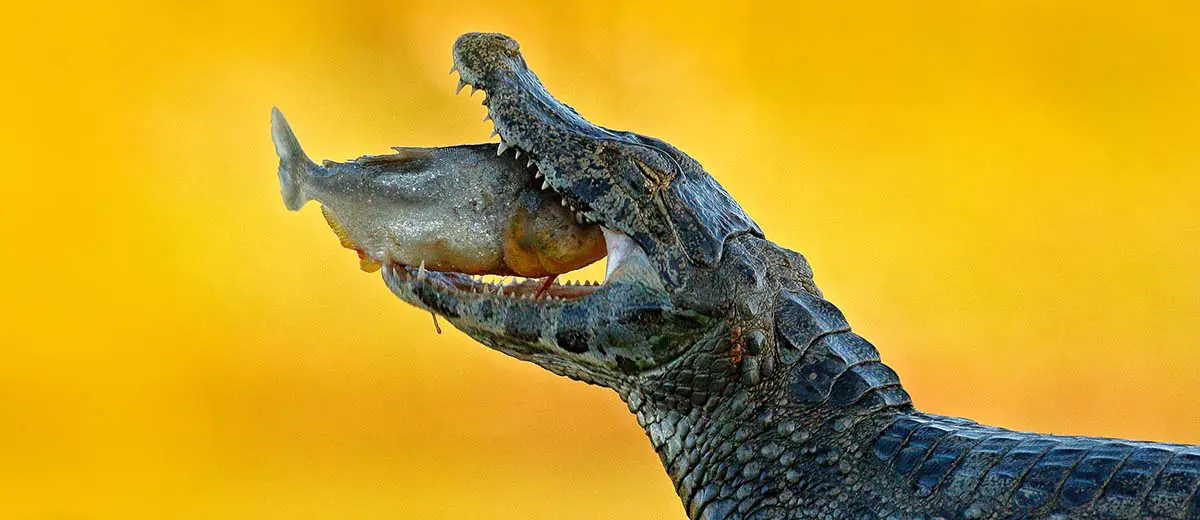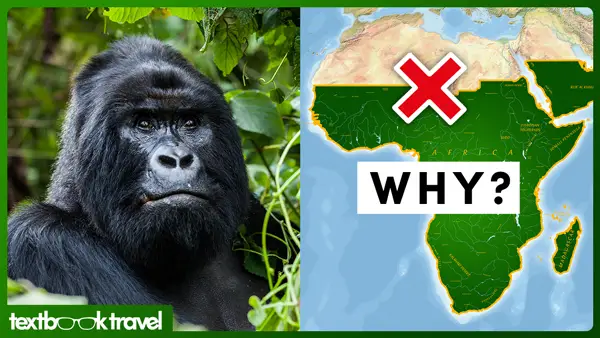All 8 Biogeographical Realms | Their Animals & Geography
From an evolutionary standpoint, the distribution of the world’s fauna can be broken down into 8 areas known as Biogeographical Realms. This classification is a similar concept to that of a biome but differs considerably by definition. A biome is a collection of living organisms all of which have evolved to exist at a specific climate. For example, the flora and fauna that thrive in the wet tropical forests of the world’s equatorial regions. On the other hand, Biogeographical Realms are entire areas historically separated for various reasons preventing migration.
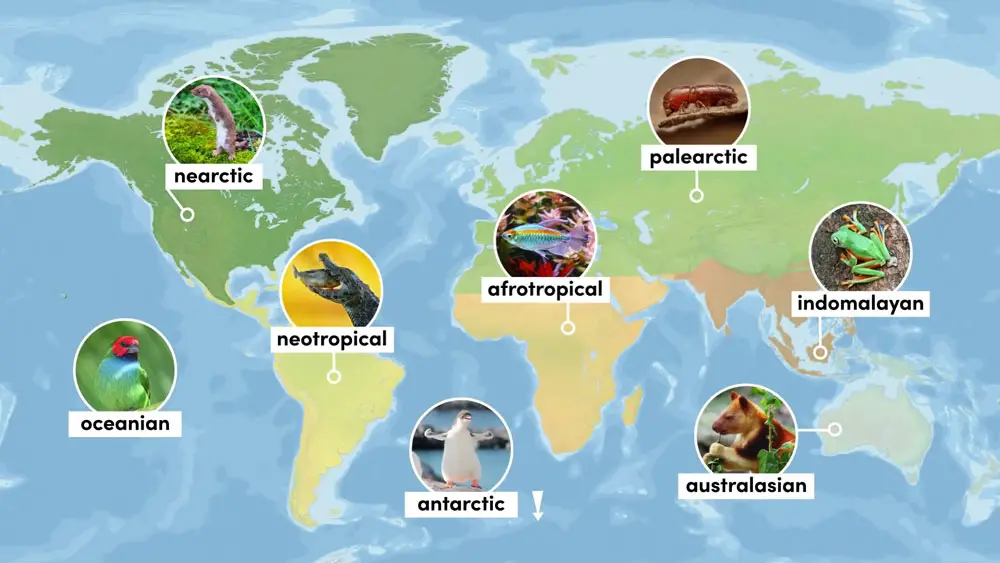
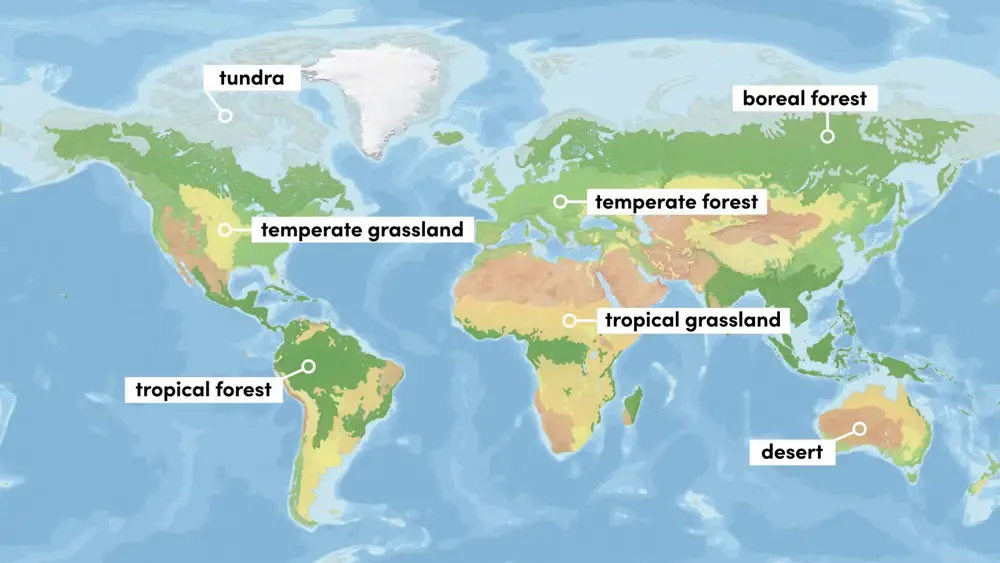
Left: The 8 Biogeographical Realms & Right: Earth’s 7 Main Terrestrial Biomes
Each of these zones contains a unique set of organisms all of which have been evolving independently for millions of years, for example, the gigantic creatures of the Afrotropical realm, which are quite different from those found in other realms, regardless of biome. In this article, we’ll delve into each realm and explore the geographical features and biodiversity found therein. Let’s dive in!
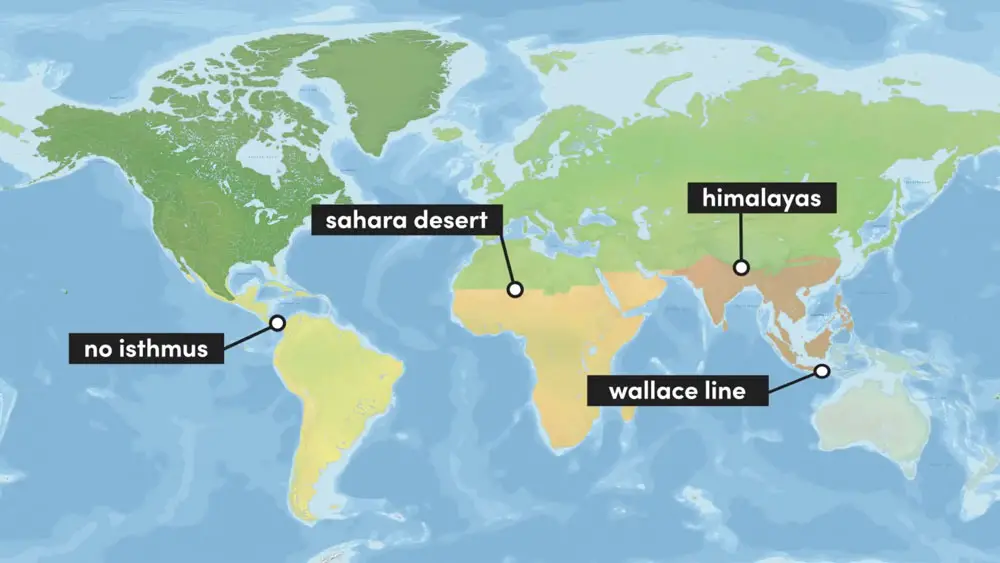
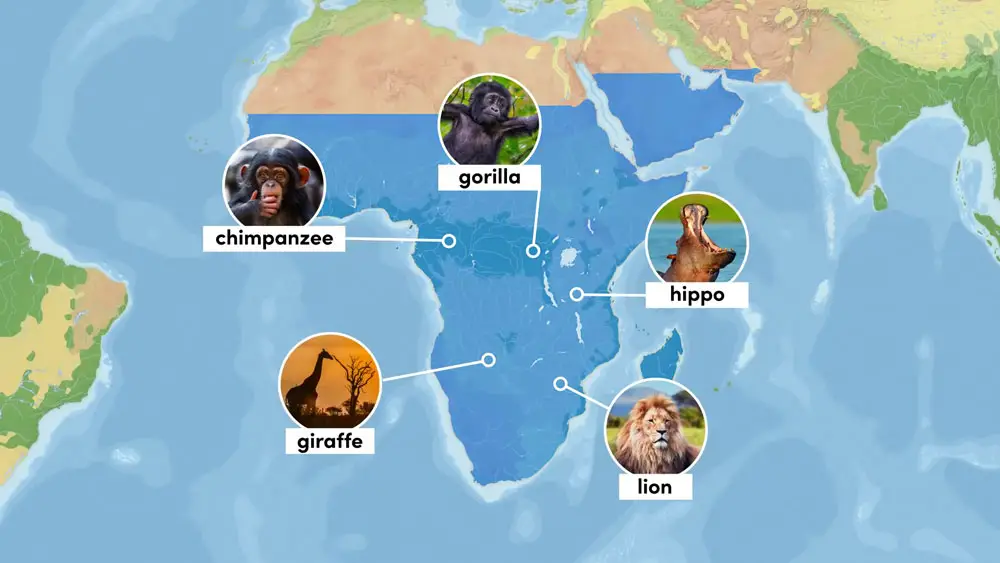
Left: Reasons for Historical Separation & Right: The Afrotropical Realm
Contents
- Antarctic Realm
- Nearctic Realm
- Neotropical Realm
- Afrotropical Realm
- Palearctic Realm
- Indomalayan Realm
- Australasian Realm
- Oceanian Realm
01 Antarctic Realm
The Antarctic realm includes the main landmass of Antarctica and several small islands off its shores. It is by far one of the most unique. The next closest realm is the neotropical, which lies over 600 miles across the freezing, turbulent waters of the Drake Passage making migration impossible for terrestrial mammals. There are very few animals who can survive the harsh conditions here and those who do thrive, fly or swim. While its outer ring of tundra is the only biome, the topography and geographic makeup of this realm are interesting, to say the least! The main landmass is split into two parts; East Antarctica and West Antarctica, which are divided by the Transantarctic Mountains. While a good portion of the east sits at over 3000m, its highest peak, Vinson Massif, is found to the west, overlooking the Ronne ice shelf.
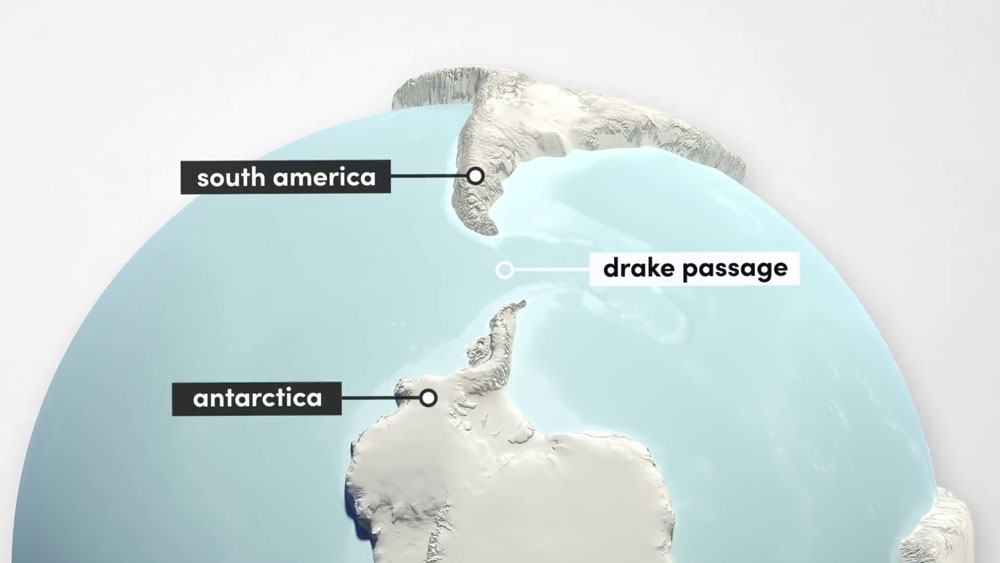
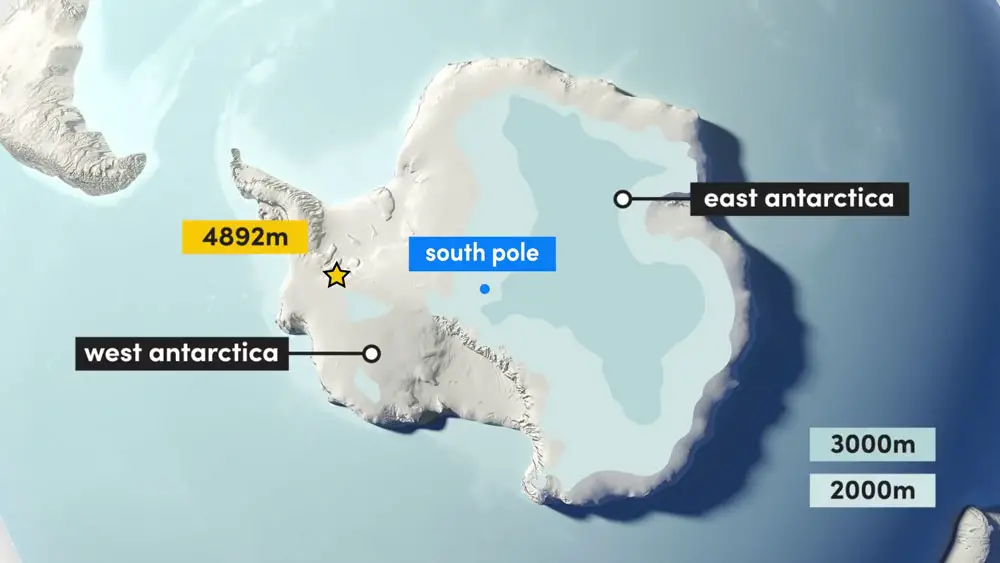
Left: The 600 mile Drake passage & Right: Antarctica With Areas of Highest Prominence
With temperatures reaching as low as -60°C and winds of up to 100 mph (160 kpm) the conditions of this realm are brutal, however, there are a few advantages. For a start, there are no land predators here, no polar bears, no arctic wolves, combine this with an abundant supply of krill and fish and for those who can put up with the conditions, this realm is quite appealing. Penguins are the best example of animals that make the most of the Antarctic. Species include the emperor penguin, who can weigh almost 100 lbs (99 lbs / 45 kg), chinstrap penguins, who are named so for the black line across their chin, and the Gentoo penguin, who evidently love it here!
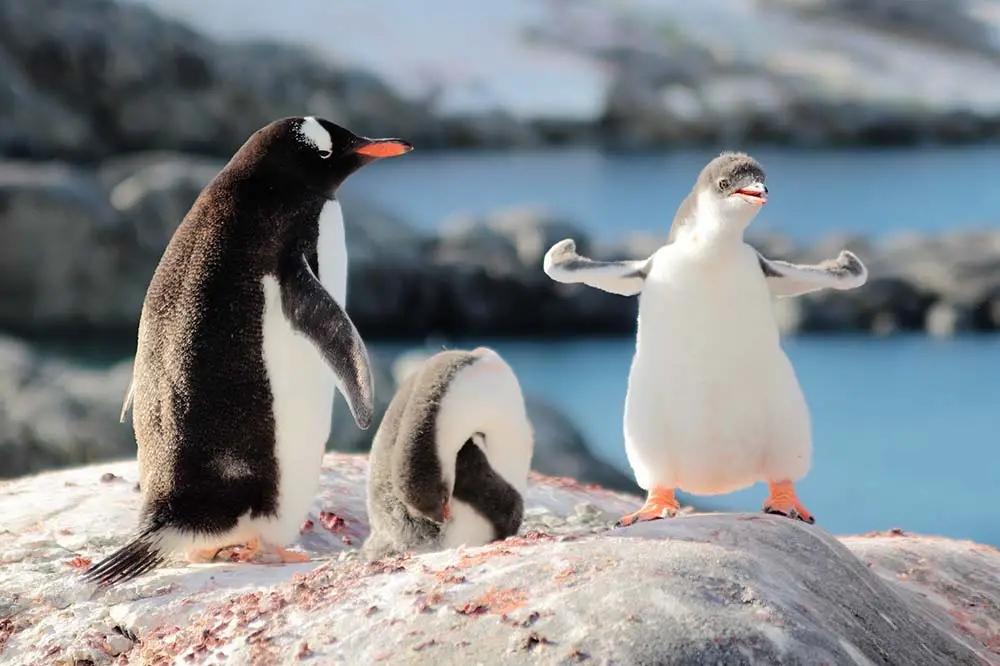
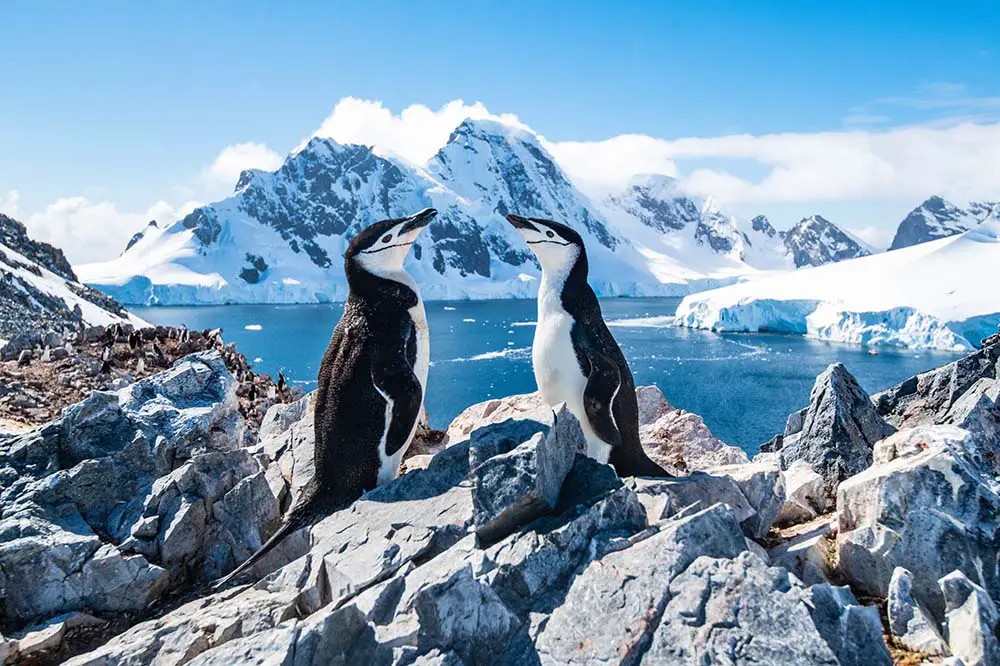
Left: Gentoo Penguin | Andrew Mobbs / Shutterstock & Right: Chinstrap Penguin | Antarctica SZakharov / Shutterstock
Patrolling the ice-cold waters of the Antarctic are pods of orca who hunt penguins, seals, fish and squid. Other whales include humpbacks, who being filter feeders, feast upon large schools of Antarctic krill, which measure no more than 2.5 inches in length (6.5 cm). Another aquatic threat to the penguins are leopard seals who can also be found on the pack ice hiding from orcas. Seabirds include the wandering albatross whose range extends to the southern regions of Australasia, Africa and the Americas.
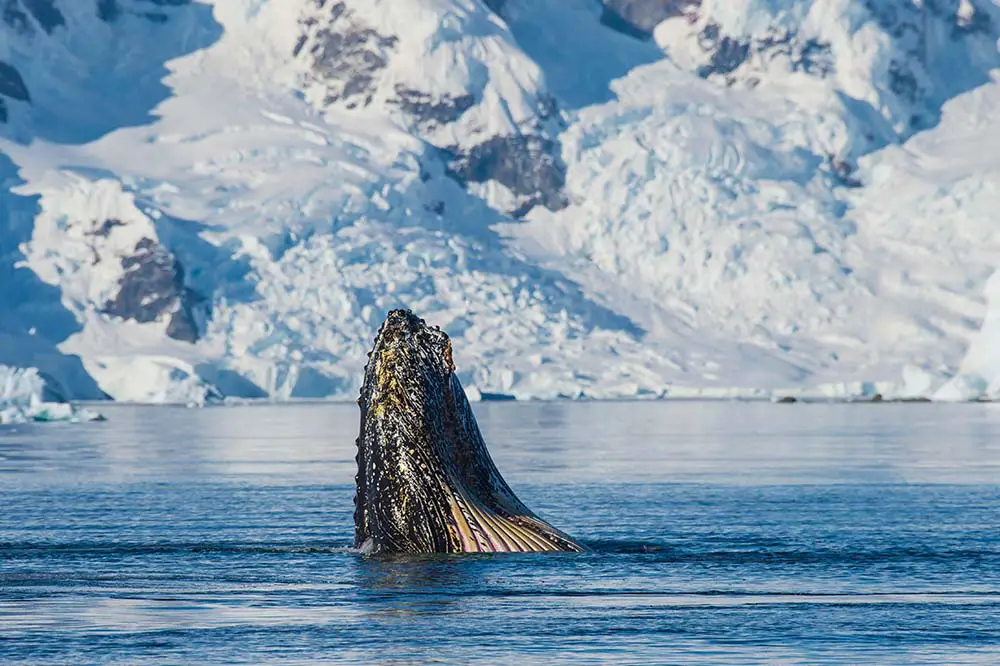
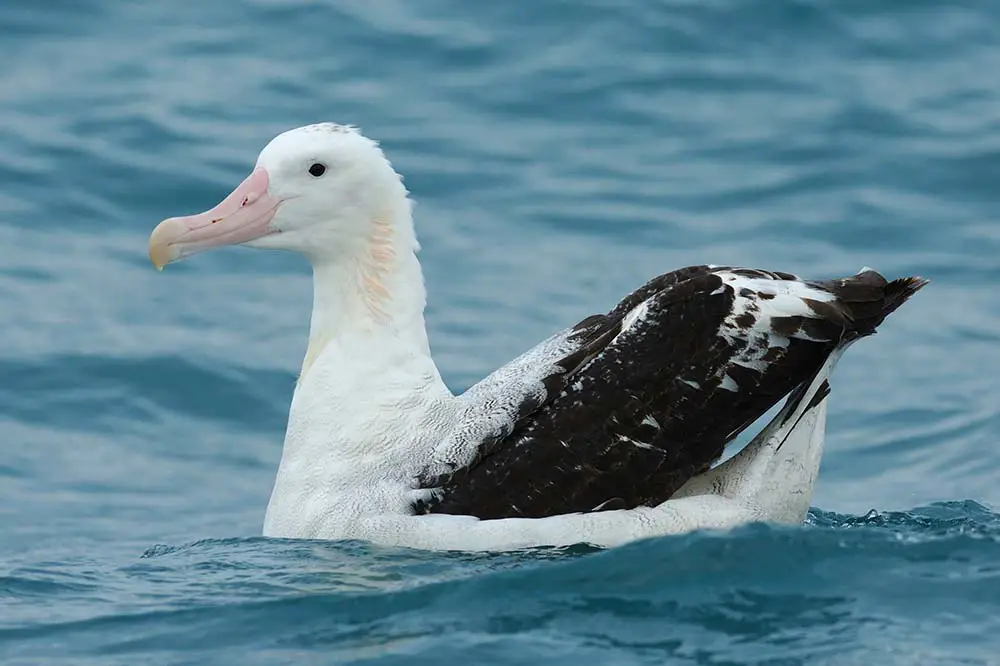
Left: Humpback Whale Feeding on Krill | vladsilver / Shutterstock & Right: Wandering Albatross in The Ocean | Hugh Lansdown / Shutterstock
02 Nearctic Realm
Up until two to three million years ago, North and South America were separated and the wildlife on each of these landmasses evolved independently. Today, these continents are joined by the isthmus of Panama and the border of these realms corresponds almost exactly with the junction of tropical forest and desert in the centre of Mexico and a small region in southern Florida. The topography of the Nearctic is epic! It features the northern or “western” half of the American Cordillera, a chain of mountain ranges that stretches from Alaska to the southern tip of South America and is the defining geographical feature of the west coast.
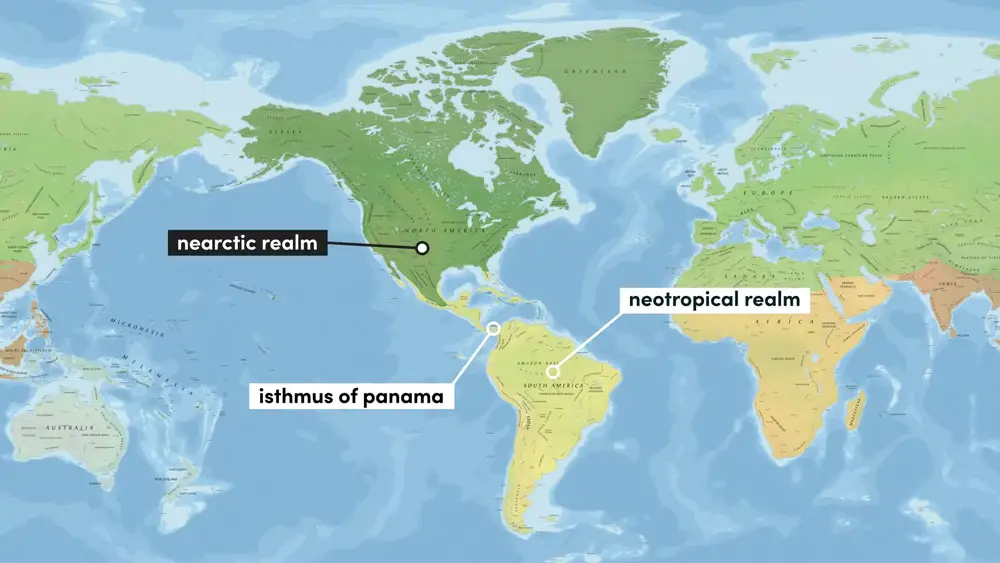
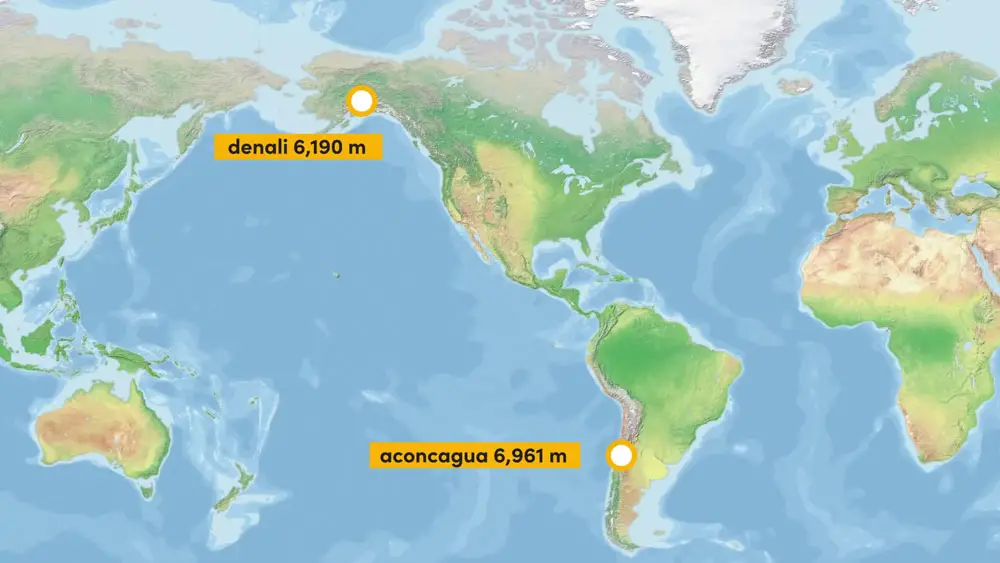
Left: The Nearctic Realm & Right: The Highest Peaks in the Americas
If there is one animal North America is famous for, it’s bears. Individuals range from gigantic Kodiak bears in Alaska and rare magical Spirit bears in British Columbia, to the polar bears of the tundra and black bears whose range extends to every corner of this realm. Moose traverse the boreal forests of the north, picking off bark, leaves and twigs from willow, aspen and balsam fir trees. The world’s smallest carnivore, the least weasel is found in more open habitats, where it preys upon mice-like rodents, such as mice!
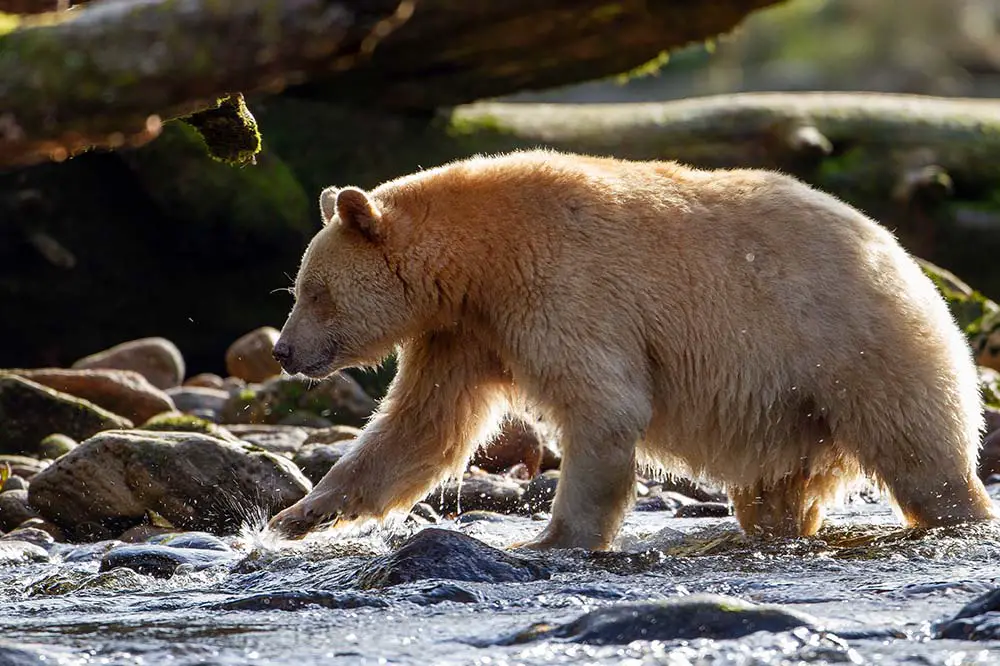
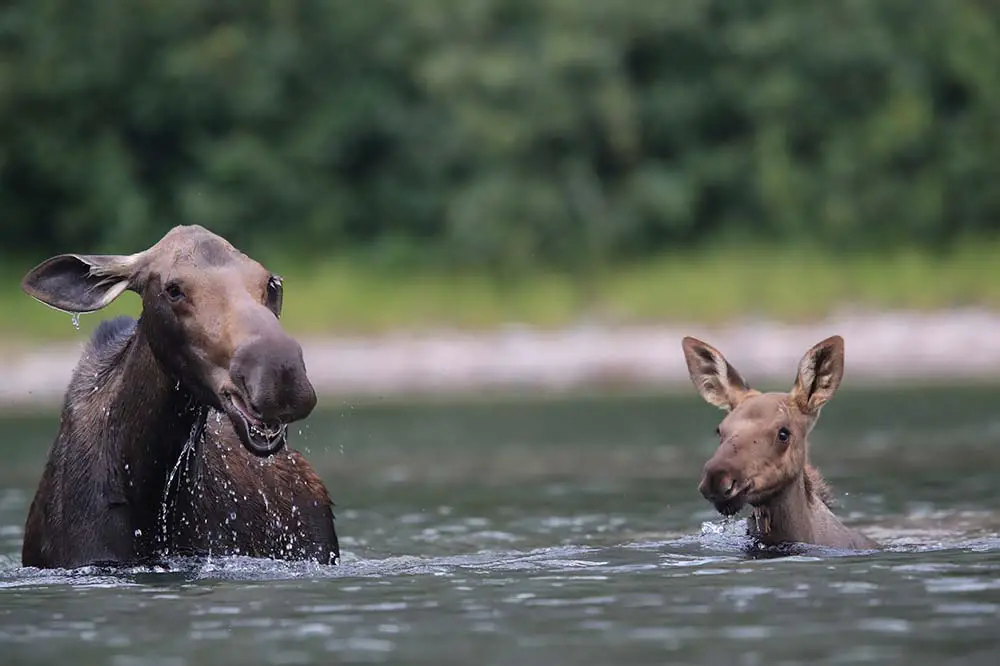
Left: Spirit Bear searching for salmon in river, Pacific Coast, BC, Canada | Lynn A / Shutterstock & Right: Moose Cow and calf in Glacier National Park in Montana | Frank Fichtmueller / Shutterstock
From Canada’s taiga in the north to temperate areas further south, the eastern half of this realm is covered almost entirely in vast swaths of forest. The Nearctic’s most iconic river is unquestionably the Mississippi; the fourth-longest in the world (6,275 km) and 5th largest in terms of drainage area. The channel catfish, the most common catfish in North America, navigate the waters of the Mississippi with paddlefish who are referred to as primitive for their lack of morphological advancements over the years, exhibited best by their elongated, paddle-shaped rostrum.
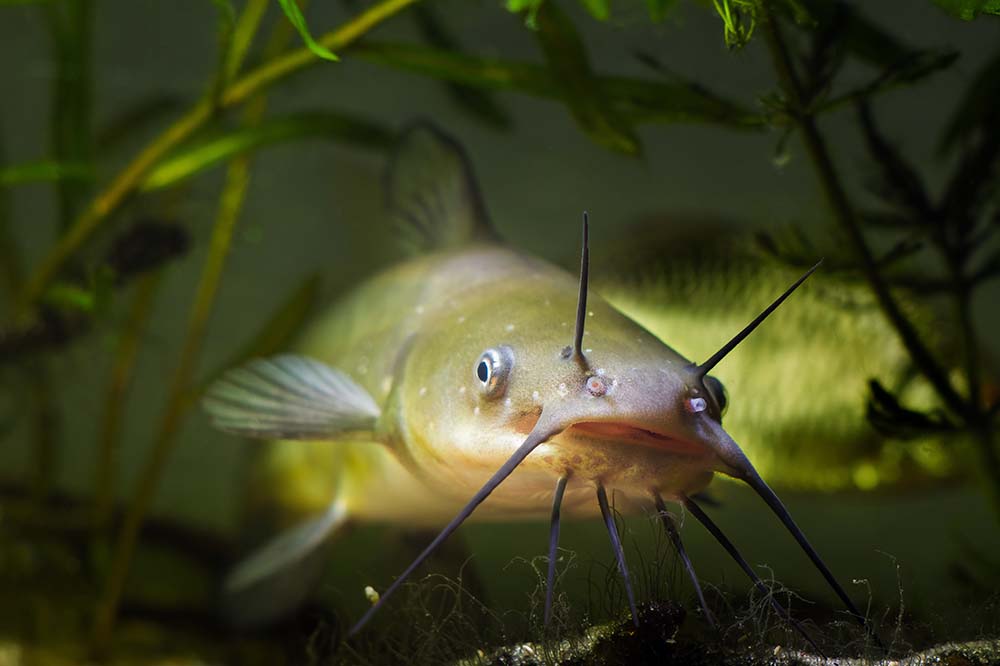
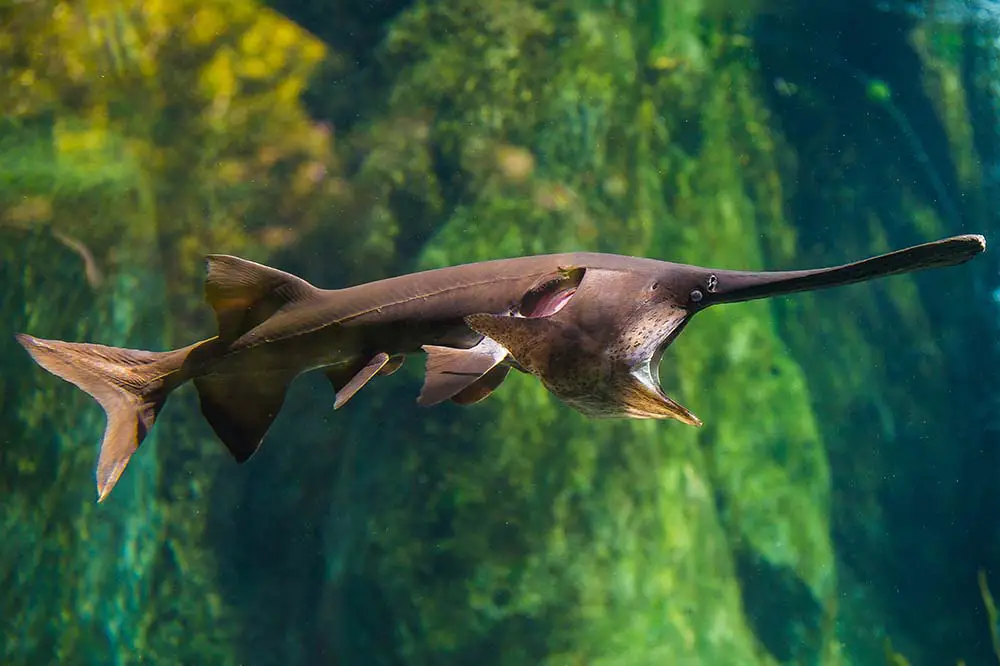
Left: Channel Catfish | Aleron Val / Shutterstock & Right: The Mississippi Paddlefish | Saran Jantraurai / Shutterstock
In the heart of the Nearctic, just east of the cordillera lies a large area of temperate grassland, known in North America as the prairies. Here, herds of pronghorn graze alongside American bison, the largest mammal in North America, weighing almost 2,000lbs (900kg / 1982 lbs). Interestingly, coyotes who are also found here were once named prairie wolves but are no longer referred to by this name. One of the most unique birds of the prairie is the greater prairie chicken. Males have bright yellow eyebrows and air sacks on their neck, the latter of which are used to make deep mating calls during breeding season. Insects include the twelve-spotted skimmer, a colourful species of dragonfly and the rusty patched bumblebee, who are vital for pollination but currently endangered.
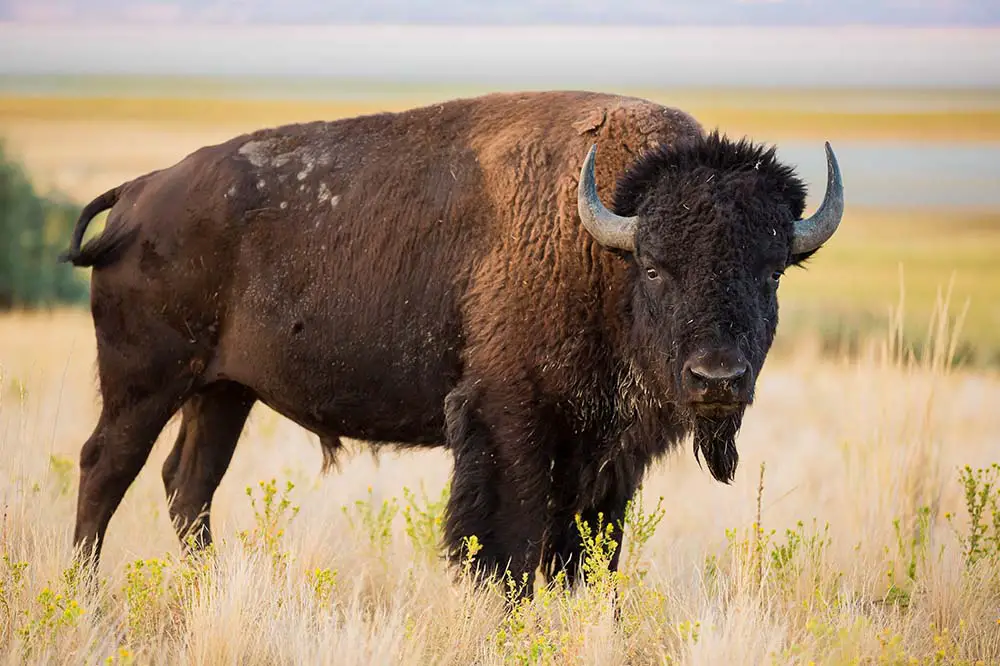
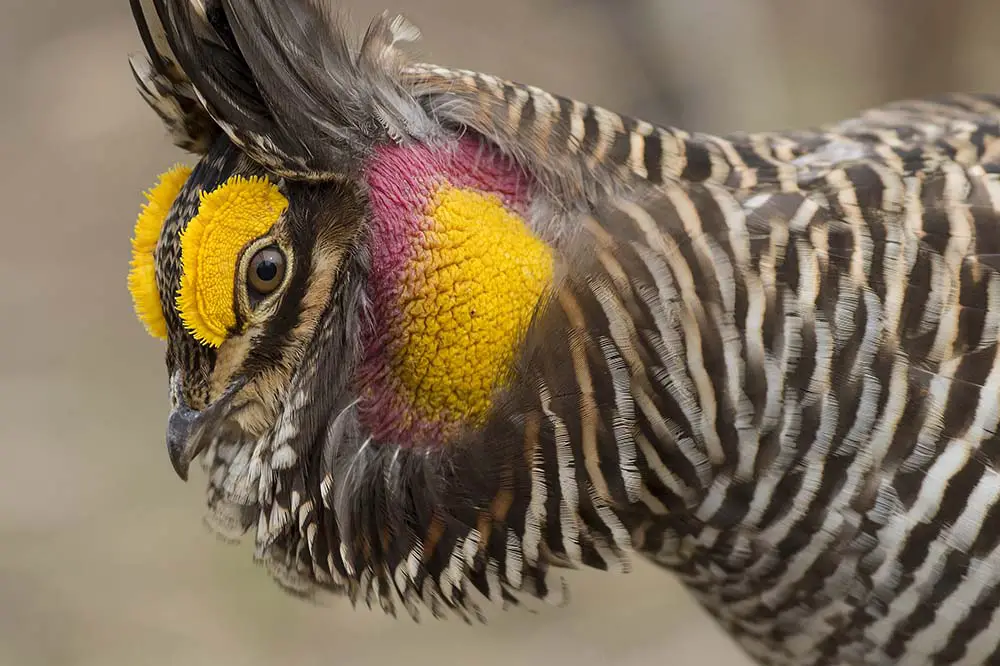
Left: American Bison | O.S. Fisher / Shutterstock & Right: Greater Prairie Chicken | Steve Oehlenschlager / Shutterstock
The hottest place on earth is debated but one location that shows up in every list is California’s Death Valley. It is located in the Mojave desert, which is part of a chain of arid areas, stretching from the northern contiguous United States to central Mexico. If there is one type of animal that does well here, it’s reptiles. Sonoran mountain kingsnakes and western rattlesnakes soak up the heat next to Great Basin collared lizards and prehistoric-looking desert horned lizards.
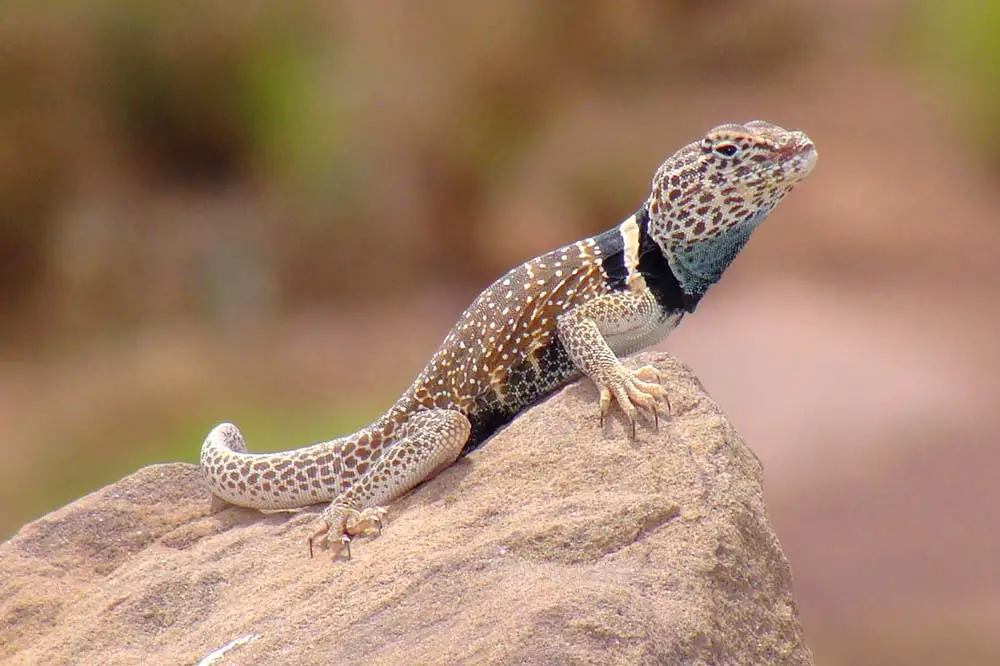
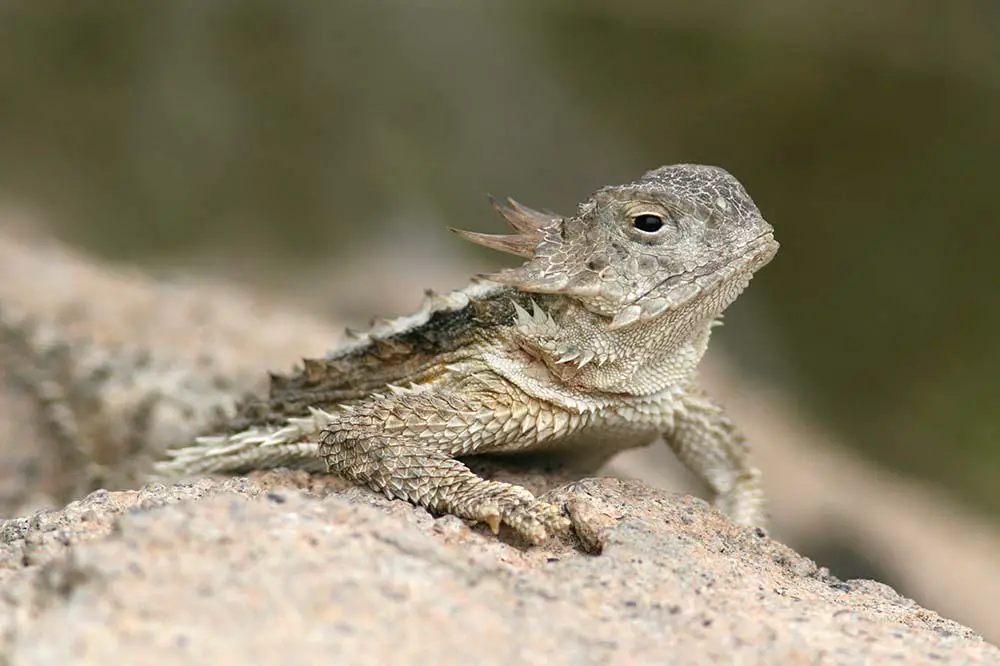
Left: Great Basin Collared Lizard | Matt Jeppson / Shutterstock & Right: Desert Horned Lizard, Sonoran Desert, Arizona | Brian Lasenby / Shutterstock
03 Neotropical realm
The neotropical realm contains 6 of the world’s megadiverse countries, Mexico, Venezuela, Colombia, Ecuador, Peru and Brazil, which is more than any other realm. Also included in the neotropics is a chain of idyllic islands known as the Caribbean. The topography here is similar to the nearctic, with a long stretch of mountainous terrain traversing the west coast, culminating in the highest peak in the Americas, Aconcagua which stands at a staggering 6,961 metres (22837 ft).
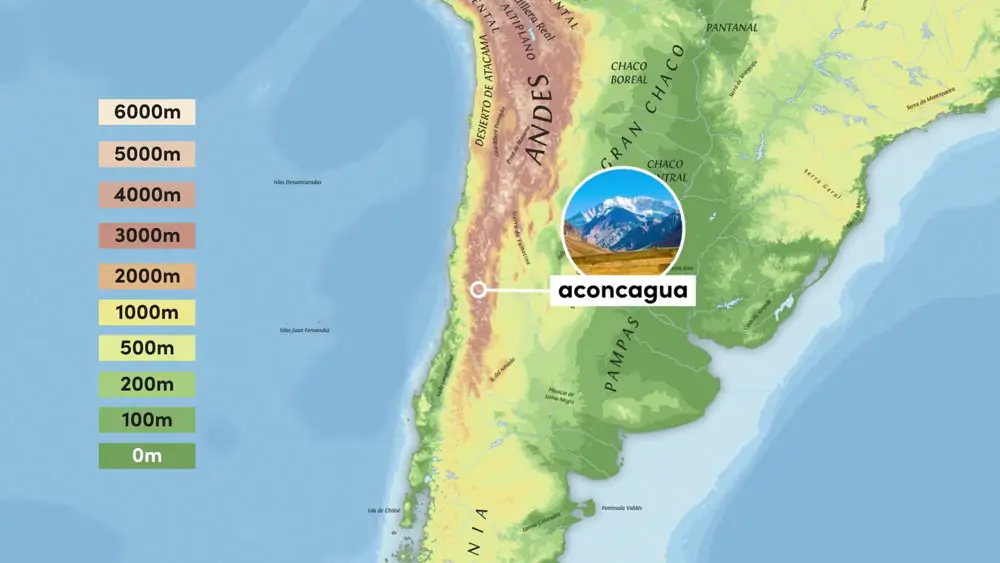
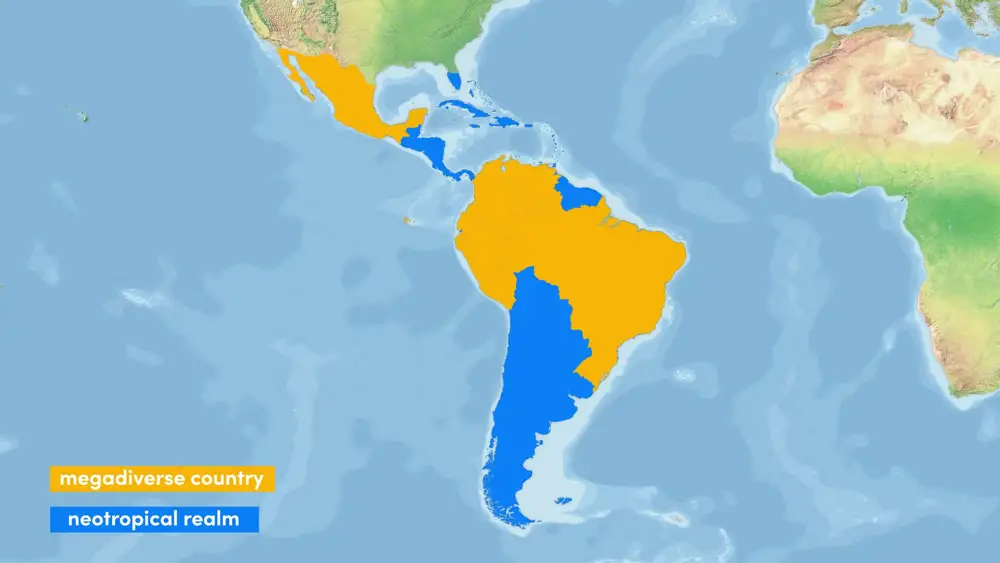
Left: The topography of the Neotropical & Right: Megadiverse Countries that lie in the Neotropical Realm
The lifeblood of this realm is arguably the greatest river on earth, the Amazon. It is second only to the Nile in length but at almost twice the size of the Congo, is by far the largest in terms of drainage area, which sits in 5 of the 6 megadiverse countries of this realm. In these murky waters, shoals of red-bellied piranhas swim beside caiman, one of the largest reptiles on the planet, and perhaps most terrifyingly bull sharks, which although they are a saltwater species, have been found 4,000 km (2,500 miles) up the Amazon.
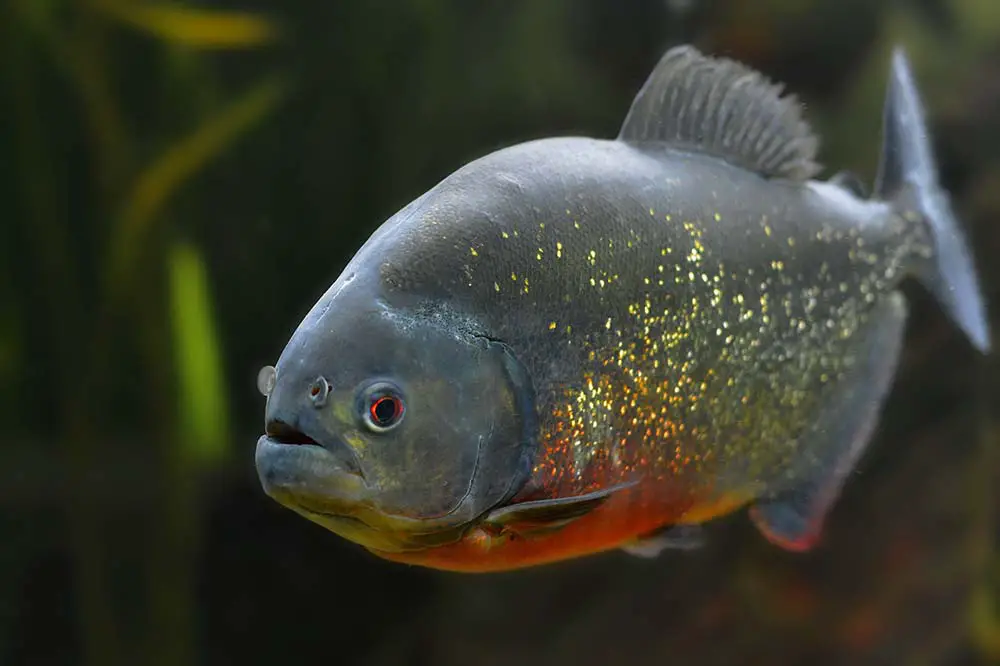
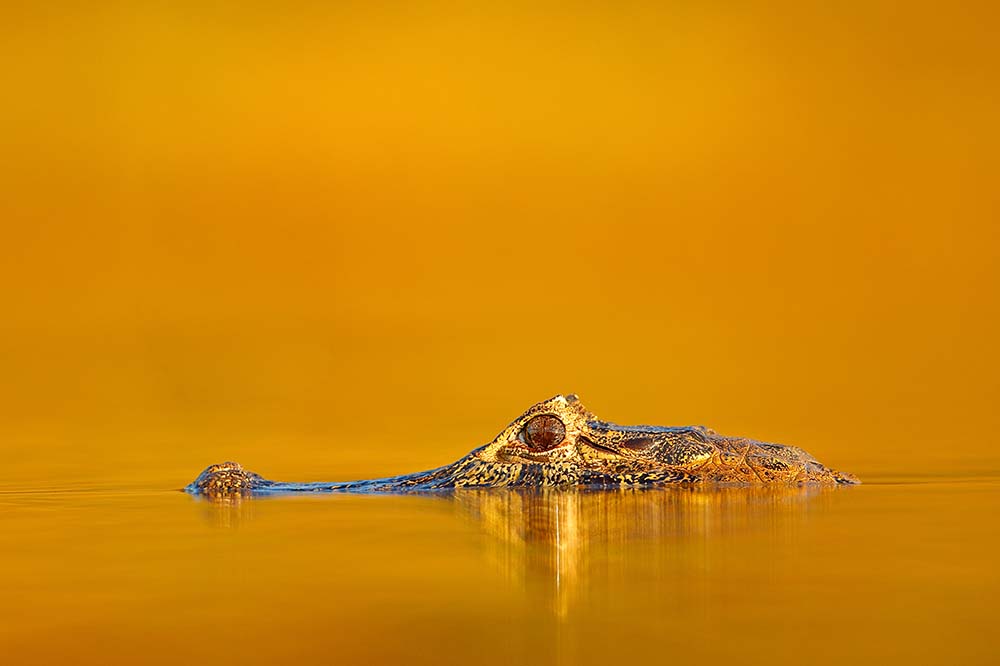
Left: Piranha Close Up | nounours / Shutterstock & Right: Yacare Caiman, Pantanal, Bolivia | Ondrej Prosicky / Shutterstock
On the banks of this great river lie vast expanses of tropical forest that stretch to its northern border with the Nearctic. The primates here are known as new world monkeys and include marmosets and howler monkeys who can be heard communicating with each other in the canopy. The insects of this biome are plentiful and can be gigantic. The Hercules beetle is one of the largest in the world, measuring up to 18 cm in length including its horn. Poisoned dart frogs also abide here and display a range of vibrant colours from neon greens and blacks to fiery reds and oranges. Potoos are a wonderfully odd-looking bird family who when their beady eyes are closed, are incredibly well camouflaged for this habitat.
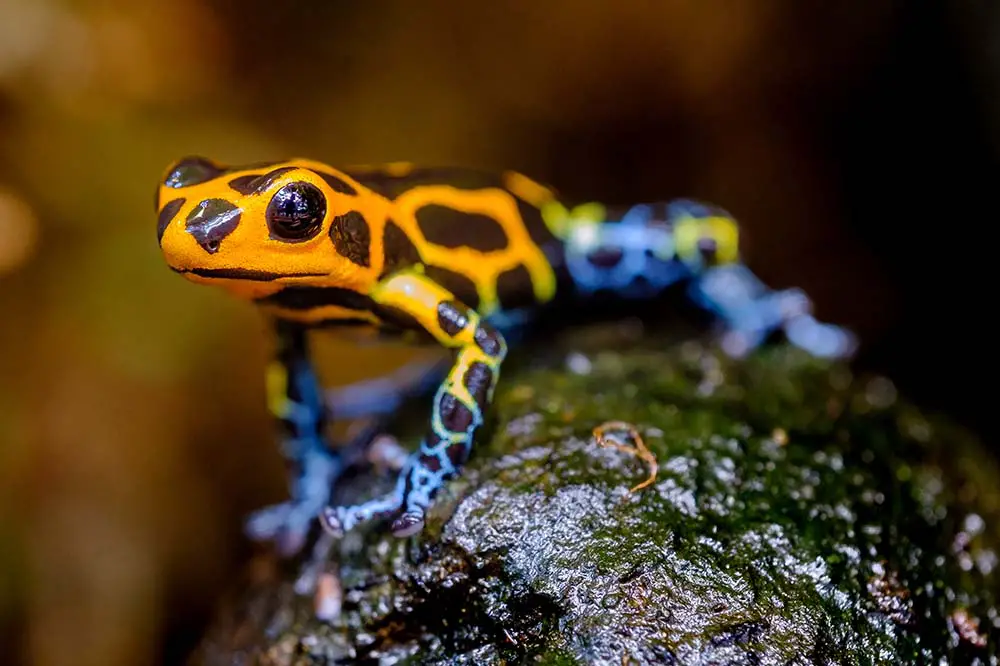
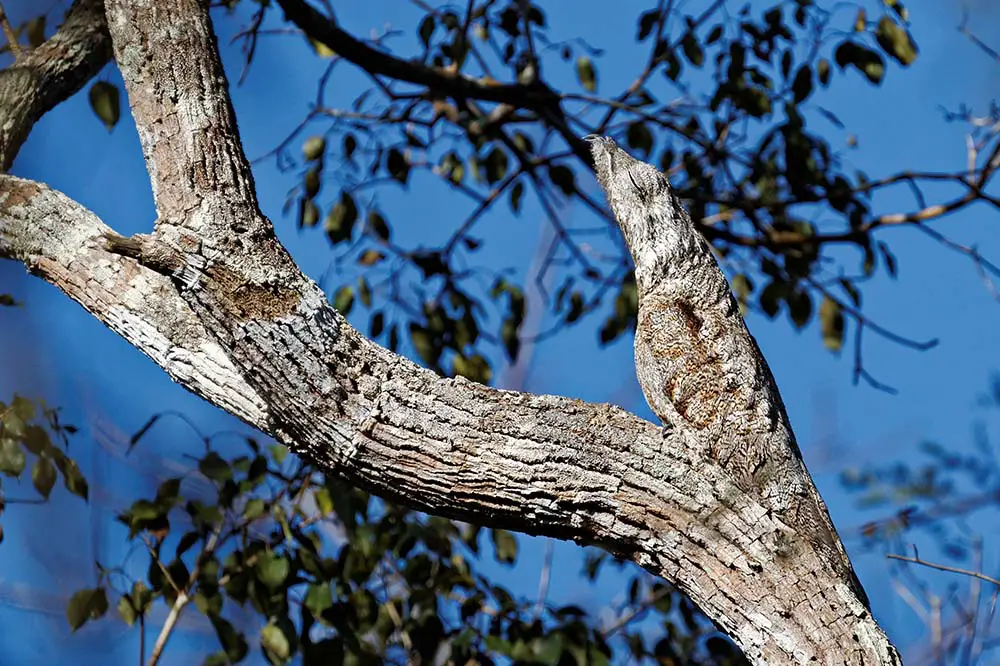
Left: Ranitomeya imitator in eastern Peru | Frank Cornelissen / Shutterstock & Right: A Camouflaged Potoo | D. Longenbaugh / Shutterstock
Bordering the tropical forests are long stretches of tropical and temperate grassland. The Pantanal is a particularly interesting region; it is an area of flooded tropical grassland, known as the world’s largest tropical wetland, home to the jaguar, the largest cat in the Americas and the anaconda, the heaviest snake in the world. The Pampas is a large area of temperate grassland found to the south. These fertile plains play host to species such as the Pampas deer, and the curious-looking Pampas fox. Another stunning area that lies south of the Pampas is Patagonia, which terminates at the end of the realm and is well known for its breathtaking landscapes.
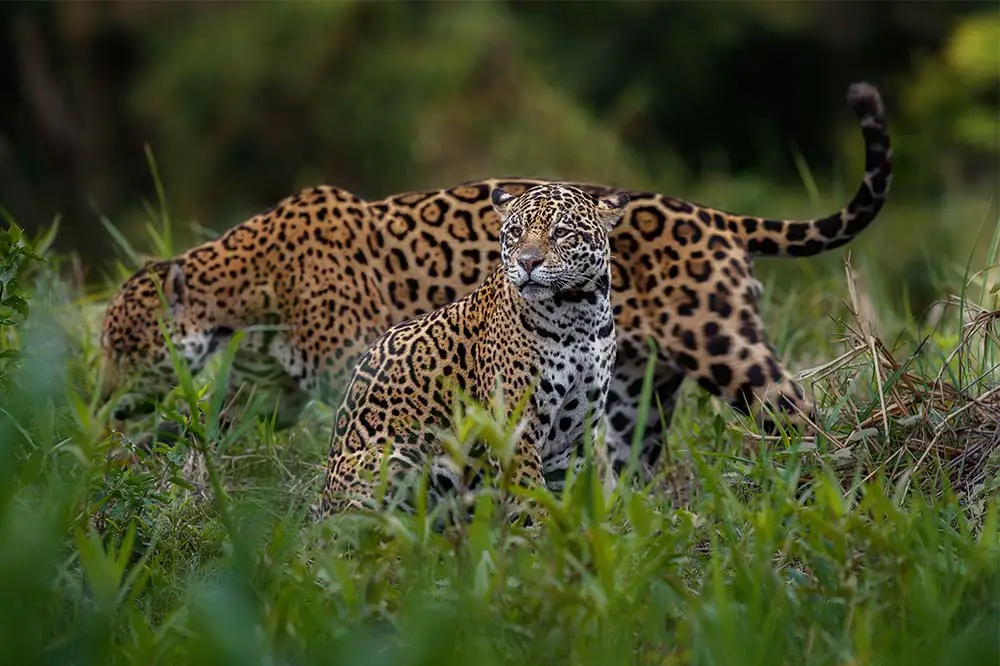
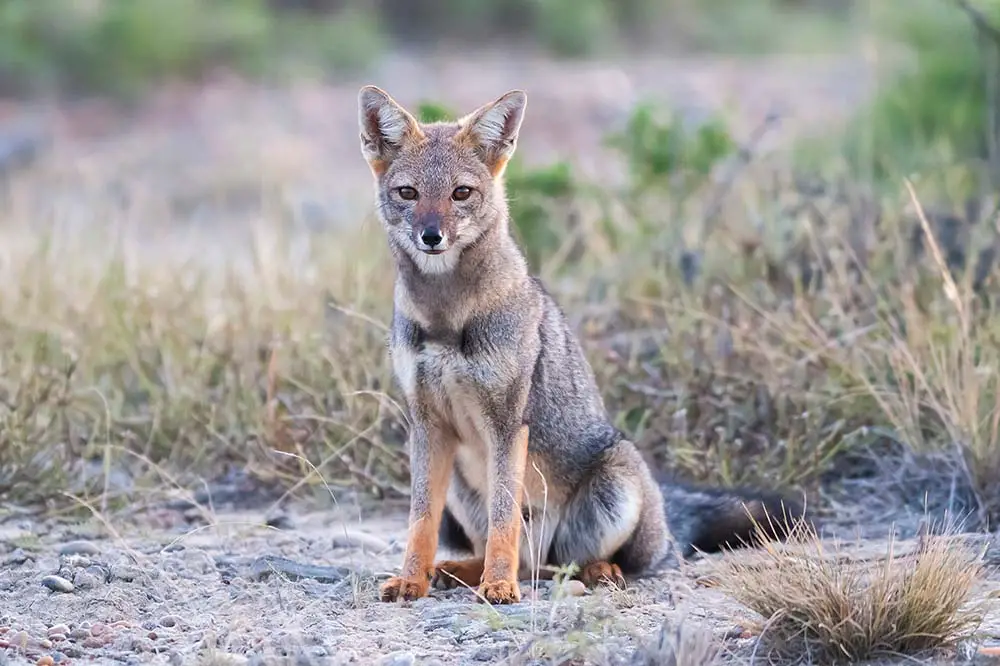
Left: Jaguars in the Pantanal | PhotocechCZ & Right: Pampas Grey fox in Argentina | Foto 4440 / Shutterstock
The last location we’ll discuss contrasts sharply with the wet fertile areas previously covered. The Atacama desert sits on the western side of the Andes Mountain Range and is known as the oldest and driest non-polar desert in the world due to the Andes blocking rainfall from the east. This desolate region is enjoyed by flocks of flamingos and is also home to Vicuña, a member of the Camelidae family who lives at higher elevations.
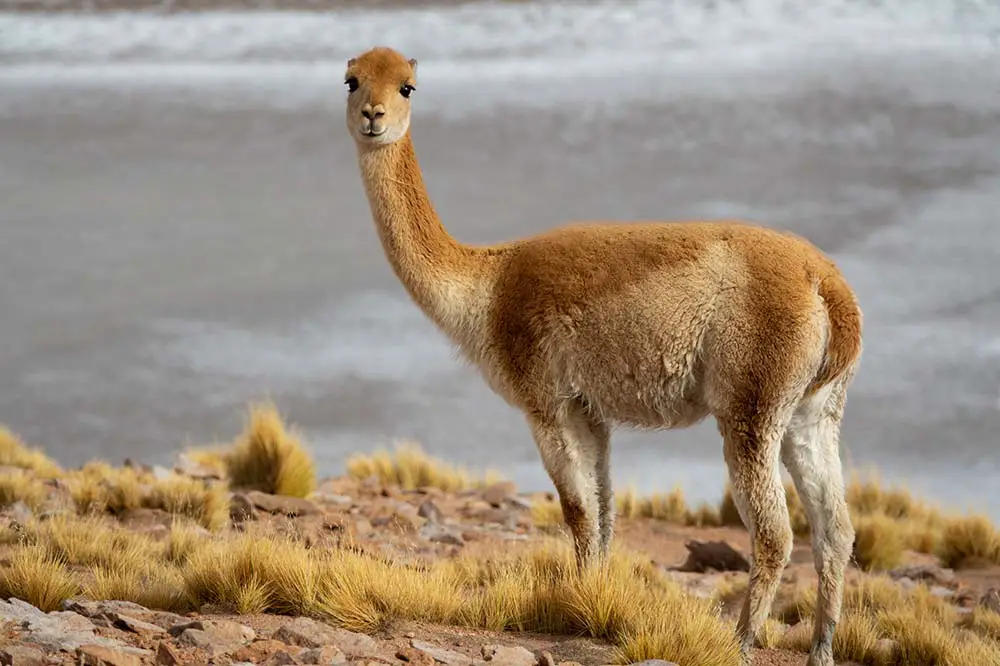
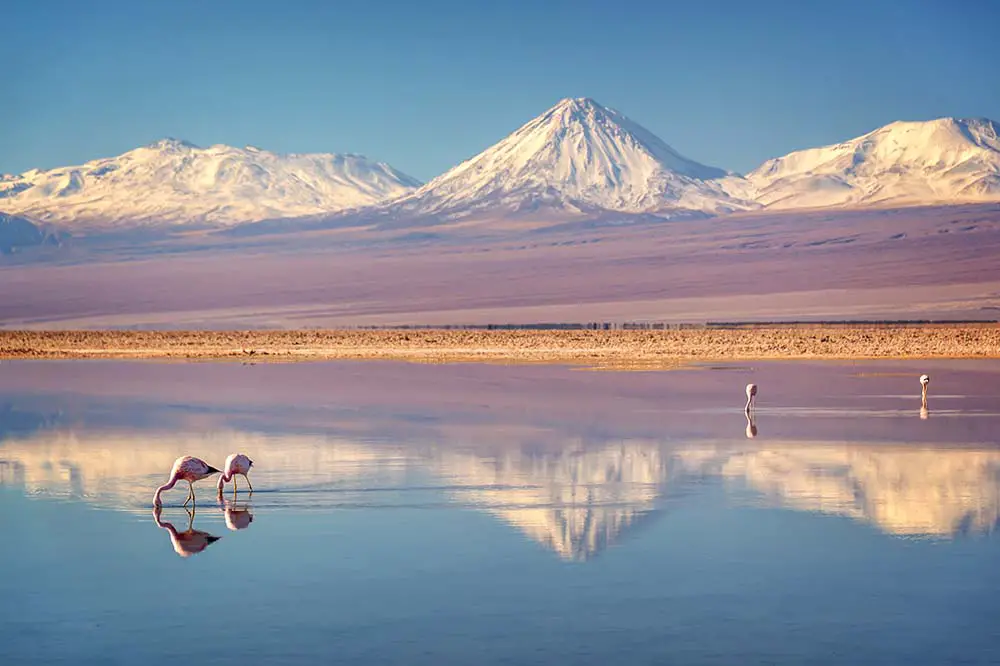
Left: Vicuña on the Atacama high plateau | FCG / Shutterstock & Right: Andean flamingos, Atacama salar, Chile | Delpixel / Shutterstock
04 Afrotropical realm
Unquestionably, the Afrotropical Realm is home to the most iconic wildlife on the planet. It makes up almost all of the African continent and migration outside of this zone is near impossible due to a strip of barren land on its northern border known as the Sahara Desert. In comparison to other ecozones, the topography of this realm is one of its lesser-renowned features although the volcanic Mount Kilimanjaro found in Tanzania ranks #4 in the seven summits being surpassed by Denali by a mere 300m.
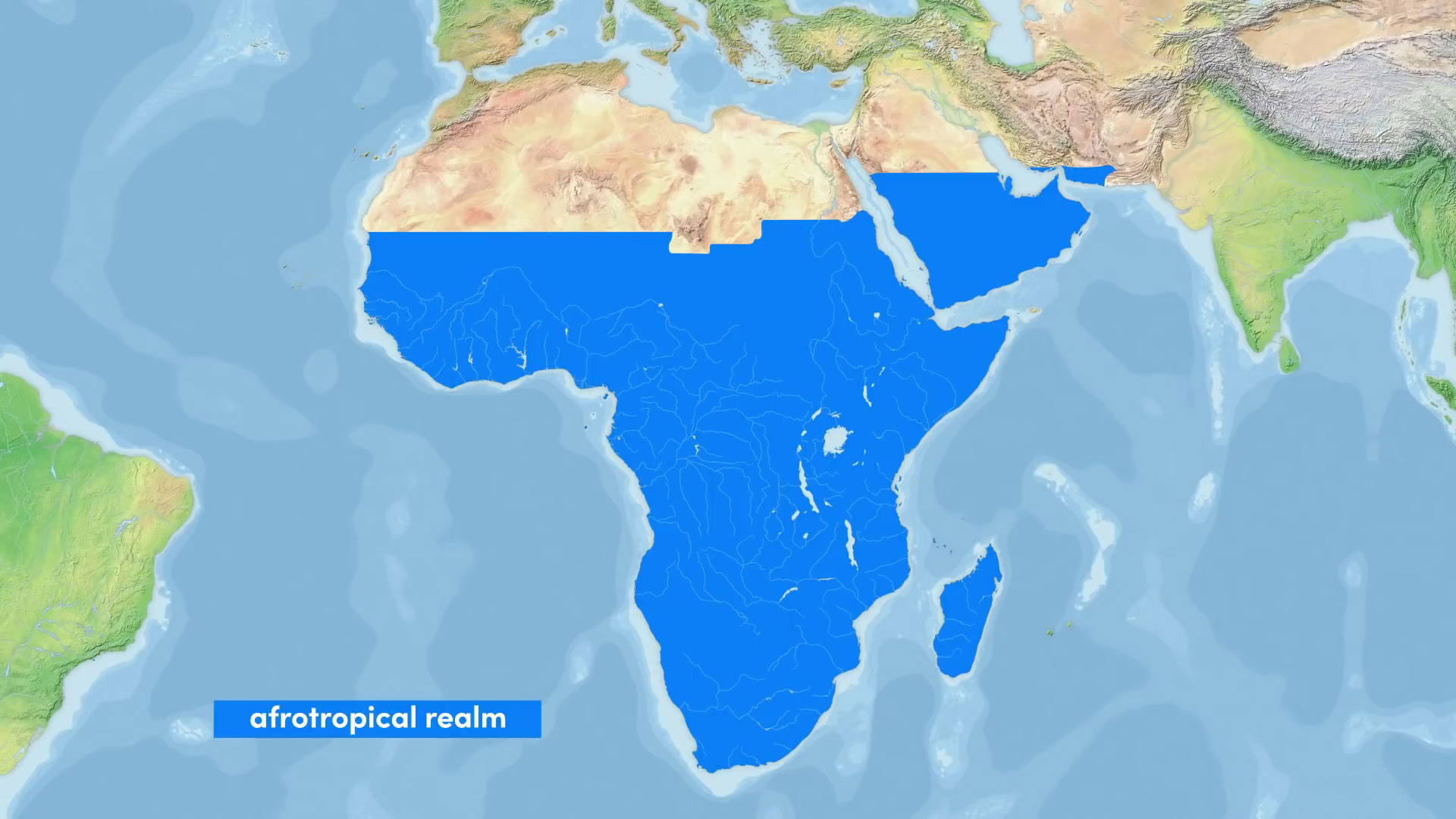
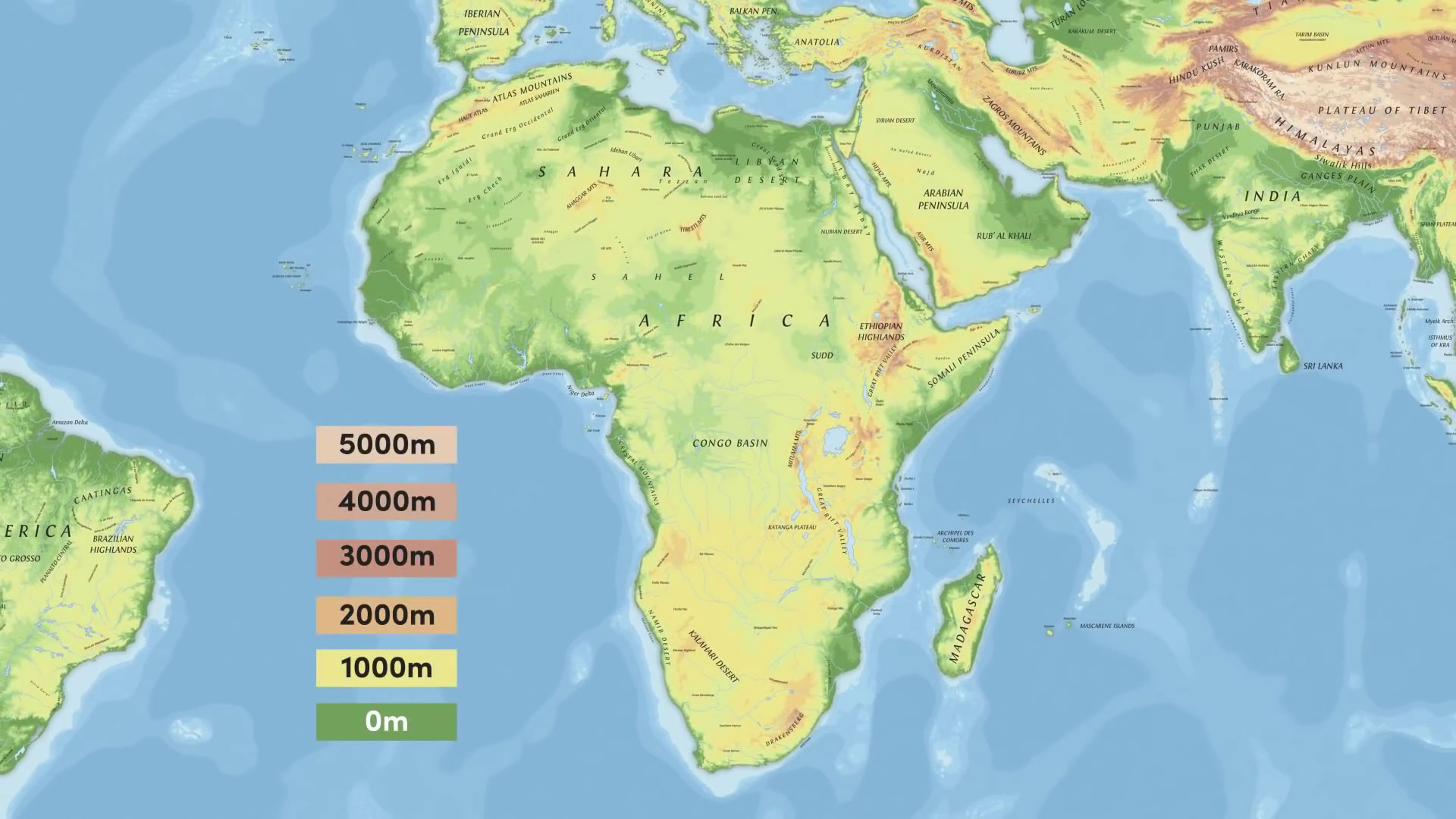
Left: The Afrotropical Realm & Right: Afrotropical Topography
The defining biome here is the savanna, this vast region of tropical grassland stretches from the southern tip of the continent to the Sahara in the north and is broken up by patches of forest and desert. The animals of the savanna can be best described as gigantic! The largest terrestrial mammal on earth is the African Bush Elephant with the heaviest individual ever recorded in Angola weighing a staggering 24,000 lbs (11,000 kg). The fact that these herbivores have evolved to become so large is unsurprising given the predators that roam these grasslands; prides of lions contain up to 40 individuals, weighing as much as 600 lbs apiece (272 kg) and packs of African wild dogs can also reach 40 in number.
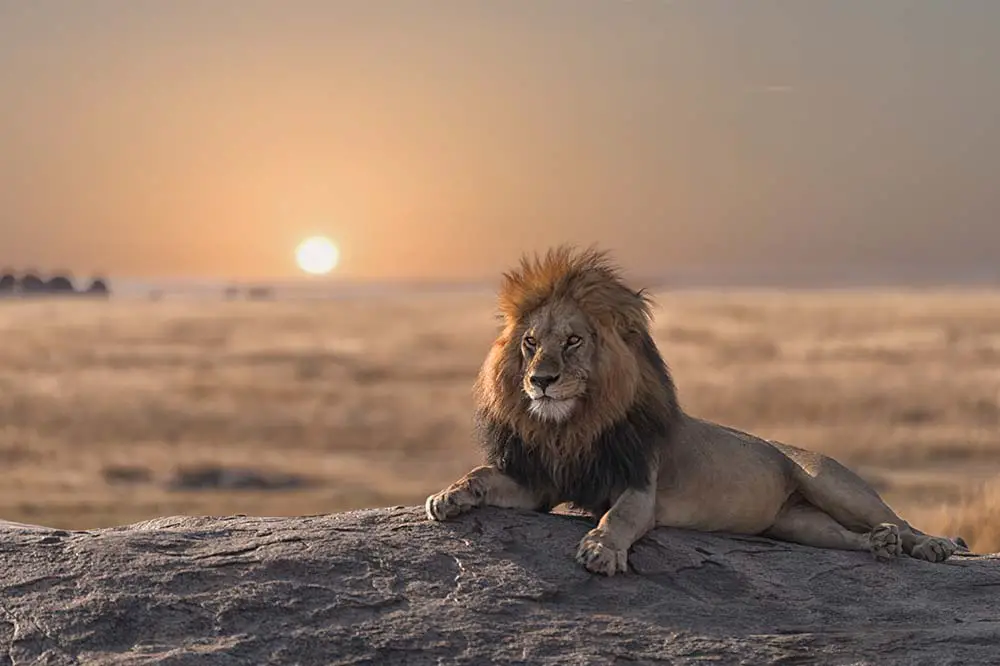
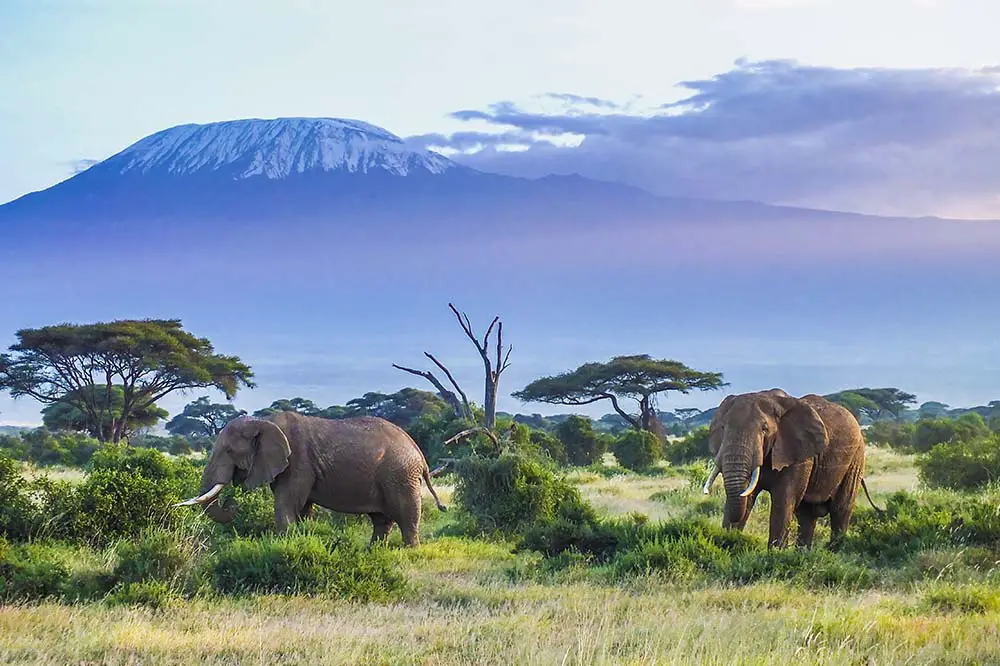
Left: Male lion | RujStudio / Shutterstock & Right: Elephants in front of Kilimanjaro | HordynskiPhotography / Shutterstock
At the heart of the Afrotropical realm lies the Congo river, which in terms of drainage area and average discharge is second only to the Amazon. The Congo features many colourful fish including the Congo tetra and various species of freshwater pufferfish (Tetraodon Mbu). Surrounding the river is a strip of tropical forest that sits directly on the equator and hosts the largest primates in the world. Eastern gorillas can weigh up to 440 lbs (200 kg) and unfortunately, are critically endangered with less than 5,000 remaining in the wild. Accompanying these peaceful primates are unique species such as the great blue turaco, the bongo with its beautiful horns and rich brown coat, and the Red-legged running frog, which is also found on the savanna.
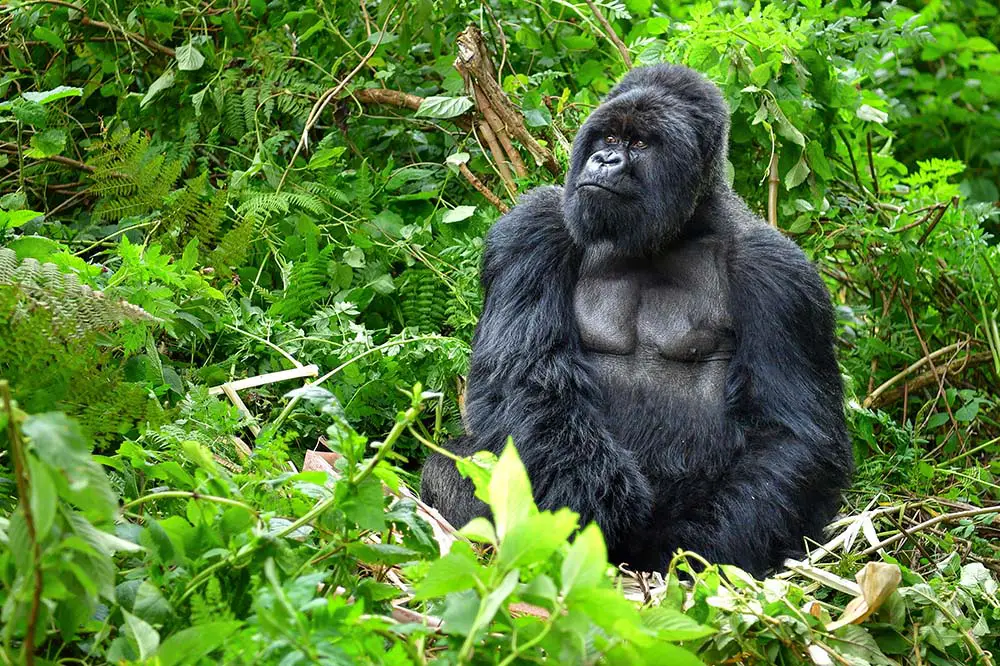
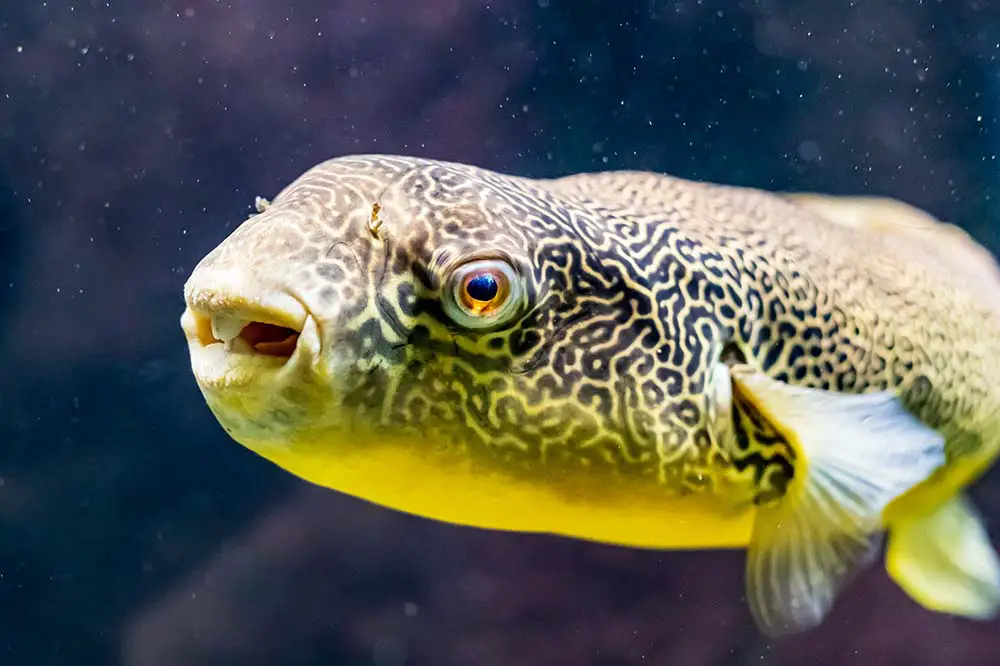
Left: Silverback mountain gorilla in Rwanda | Onyx9 / Shutterstock & Right: Tetraodon Mbu Freshwater Puffer Fish | yuliya ivanenko / Shutterstock
The island of Madagascar is the fourth largest island in the world and one of the most biodiverse areas on the planet. Here, camouflaged chameleons use their tongues as projectiles to snatch unsuspecting insects on whom they prey. The Giraffe weevil is endemic to the island and is sexually dimorphic, with males exhibiting necks up to 3 times longer than that of a female.
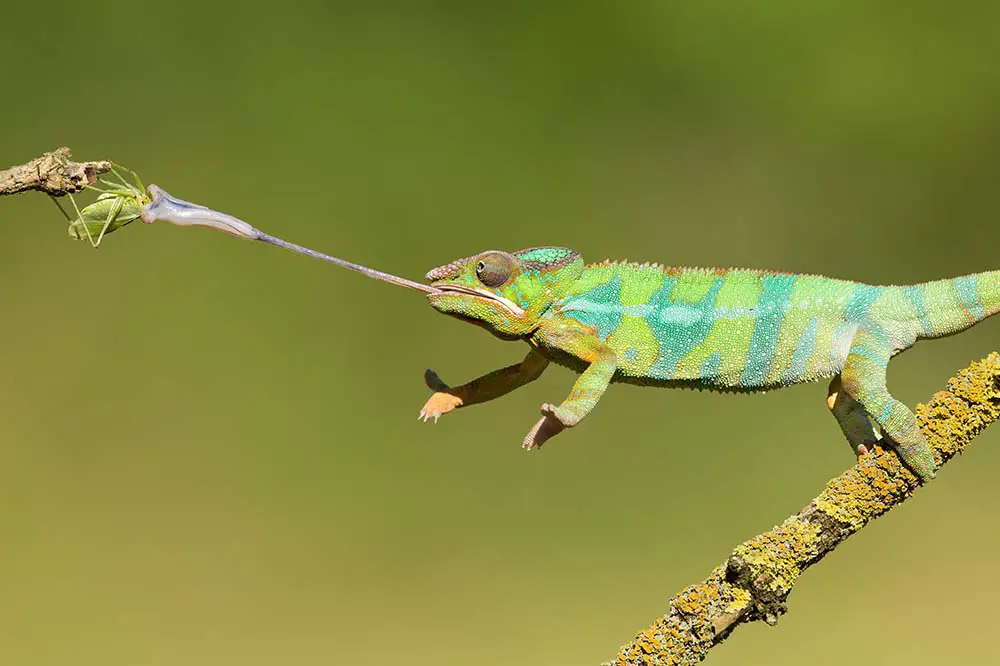
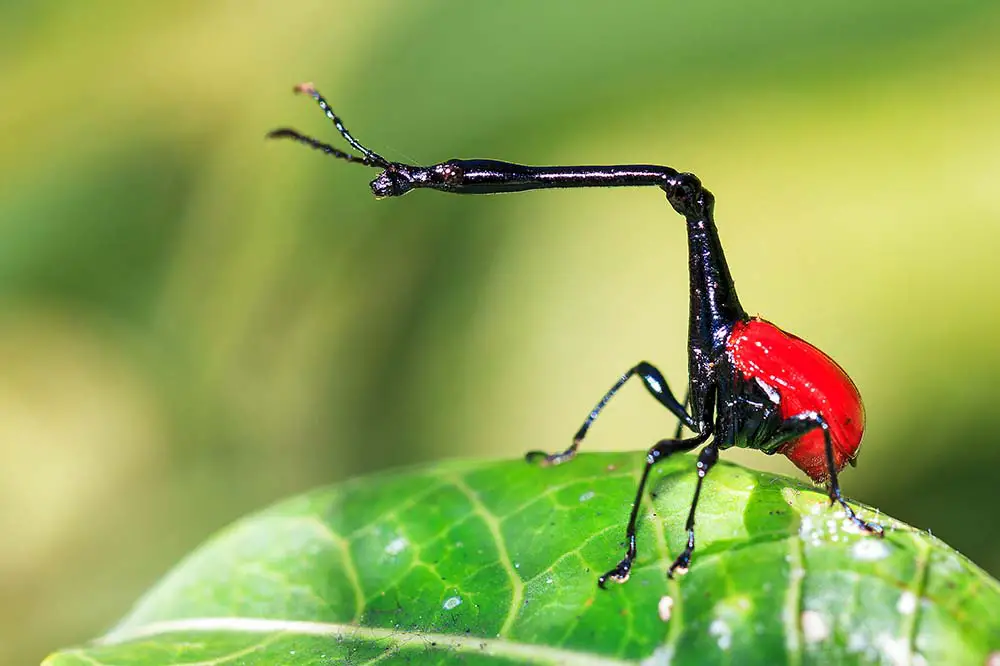
Left: Panther chameleon in Madagascar | Milan Zygmunt / Shutterstock & Right: The giraffe weevil in Andasibe Mantadia National Park, Madagascar | Dennis van de Water / Shutterstock
The last interesting feature we’ll explore is the Kalahari desert. This incredible stretch of land sits at 900 metres above sea level on the interior plateau of Southern Africa. There are a surprising number of animals in this arid region including meerkats, flocks of colourful flamingos, the blue-headed agama lizard, and the aardvark, a largely nocturnal mammal whose range extends throughout most of sub-Saharan Africa.
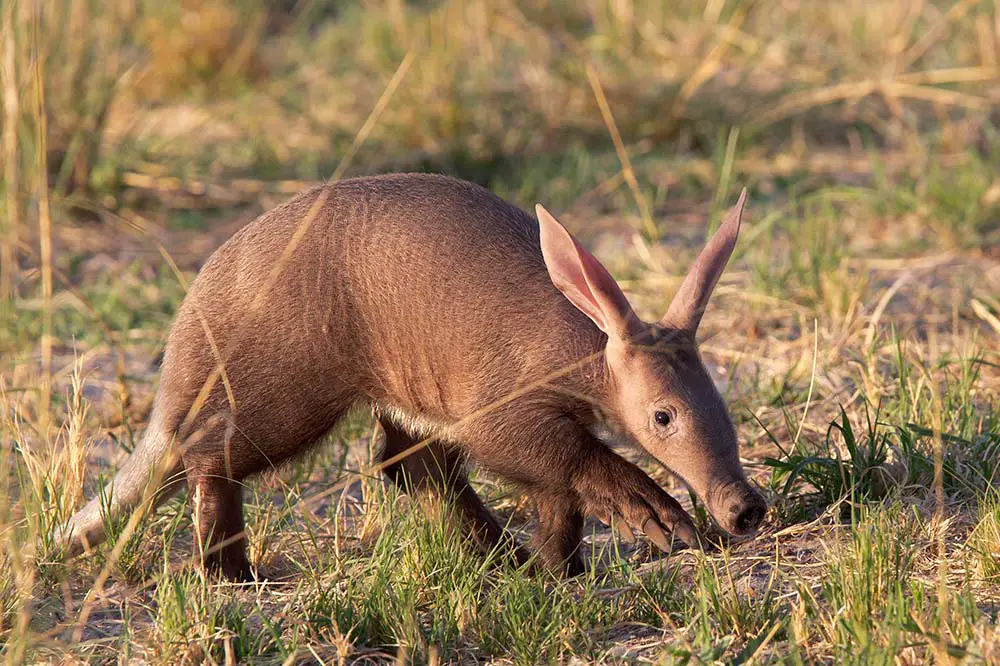
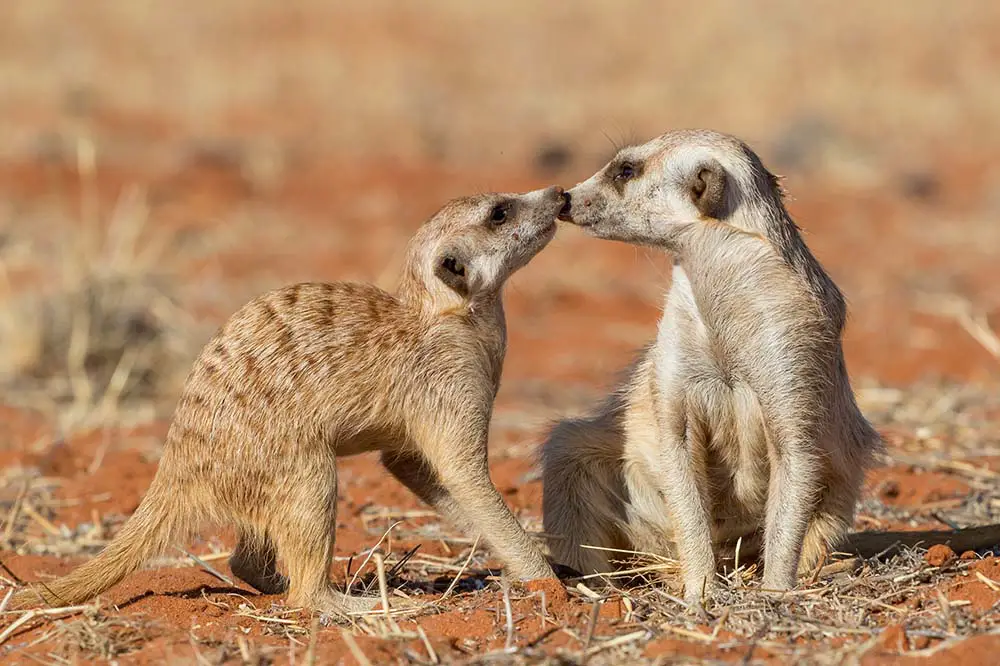
Left: Baby Aardvark in the Okavango Delta, Botswana | Thomas Retterath / Shutterstock & Right: Meerkats playing on the sand, Kalahari desert, Namibia | Luca Nichetti / Shutterstock
05 Palearctic realm
The Palearctic is the largest biogeographic realm on earth, occupying 54 million square kilometres (20.9 square miles), which is well over twice the size of the Nearctic, the second largest. In addition to the Sahara desert, which sits on its south-western border, this zone is separated from the Indomalayan realm by the highest mountain range on earth, the Himalayas. There are several other mountain ranges that sit within this realm including the Caucasus (Mount Elbrus 5,642 m / 18,510 ft) and the Alps (Mont Blanc 4,810 m / 15,781 ft).
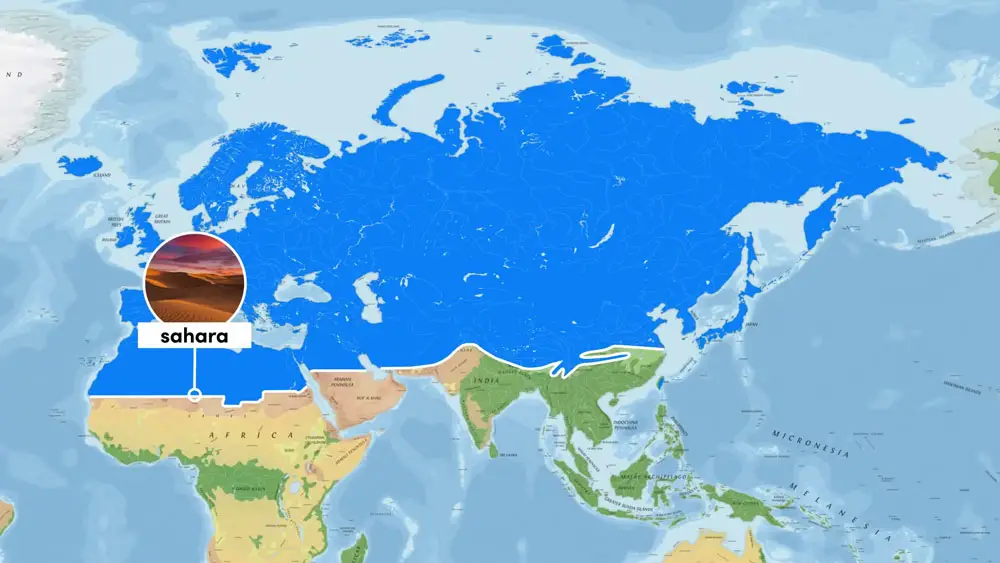
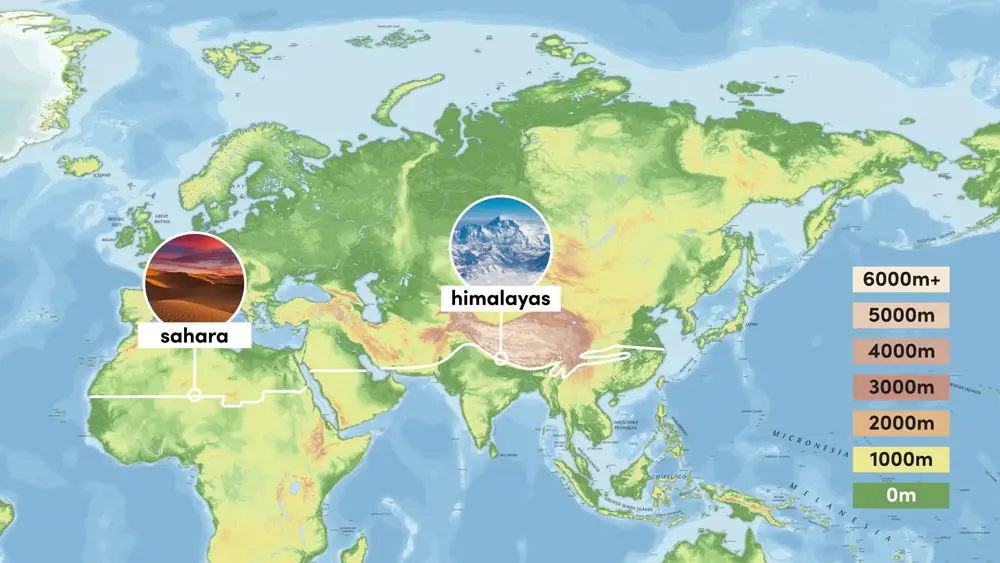
Left: The Palearctic Realm & Right: Topography of the Palearctic
At the top of the Palearctic lies the tundra. The animals here are well equipped for the freezing conditions and many of them exhibit white camouflage including arctic foxes and wolves and birds such as rock ptarmigans and snow geese. Beneath the tundra lies a strip of boreal forest known as the taiga. Many species of insect live in the boreal zone; the European spruce bark beetle is considered by some to be a keystone species and leaves a fascinating trail of destruction in the spruce it devours. One of the world’s most intimidating creatures abides only in the boreal forests of far eastern Russia, the Siberian tiger, the largest member of the Felidae family.
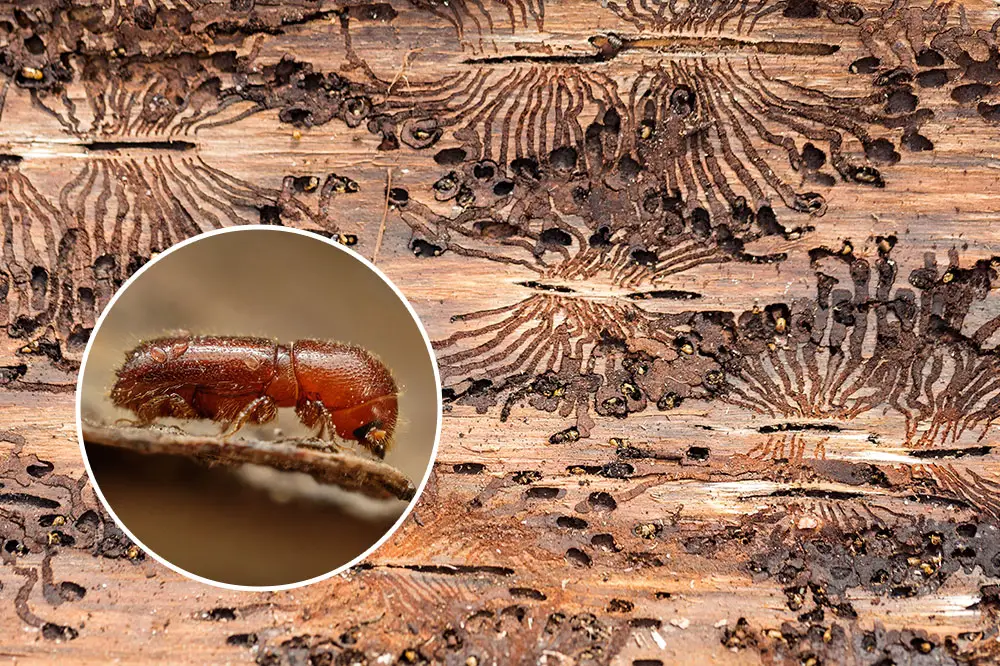
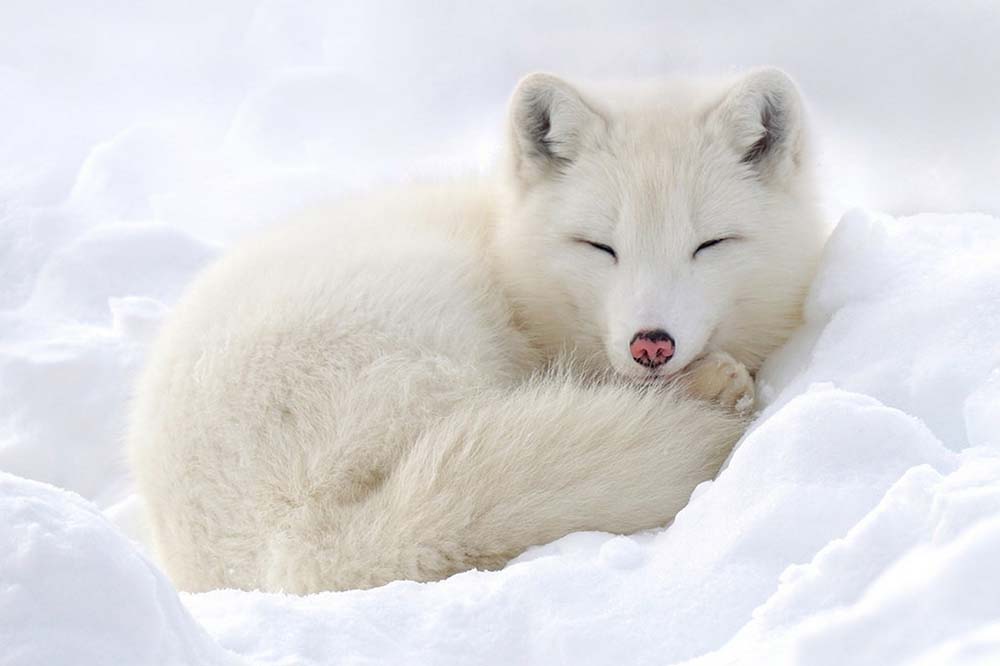
Left: European Spruce Bark Beetle | Mi St & Wjarek / Shutterstock & Right: Arctic fox in the snow | L-N / Shutterstock
The area south of the boreal forest can best be described as a patchwork of temperate forest, temperate grassland and desert. The Gobi desert sits northwest of the Tibetan plateau and is one of the most inhospitable places on earth. With windchill, temperatures can range from -40°C (-40°F) in the winter to 45°C (113 °F) in the summer. Although there are sand dunes here, most of the landscape is made up of flat barren basins and colourful rock formations. One of the few mammals to excel in this habitat is the Bactrian camel, which exhibits thick fur to stave off the frigid Gobi nights. There are also several species of pit viper endemic to the Gobi including the Haly’s or Siberian Pit Viper.
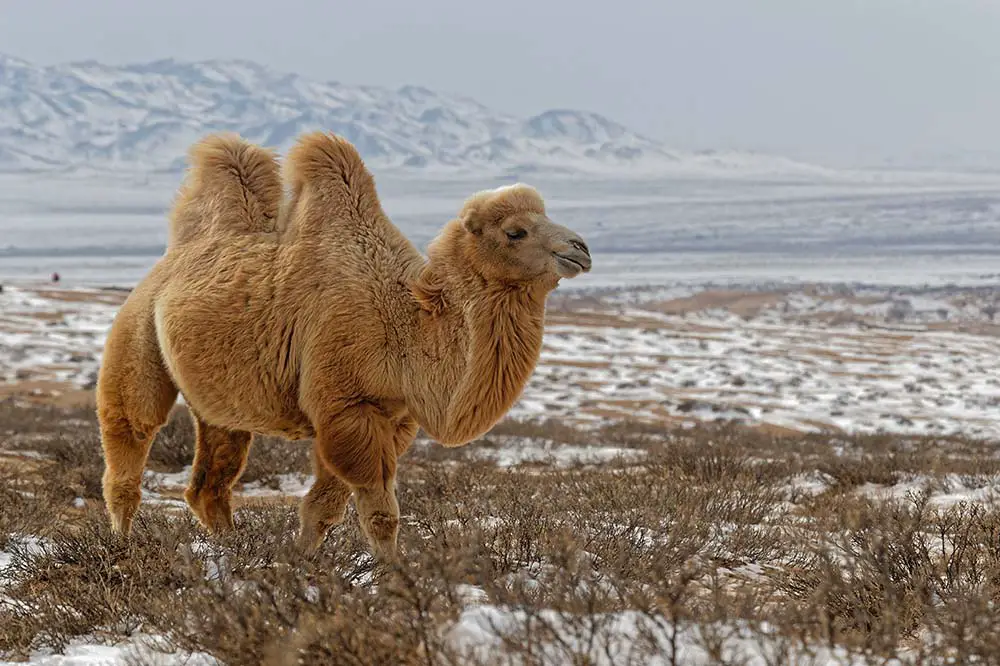
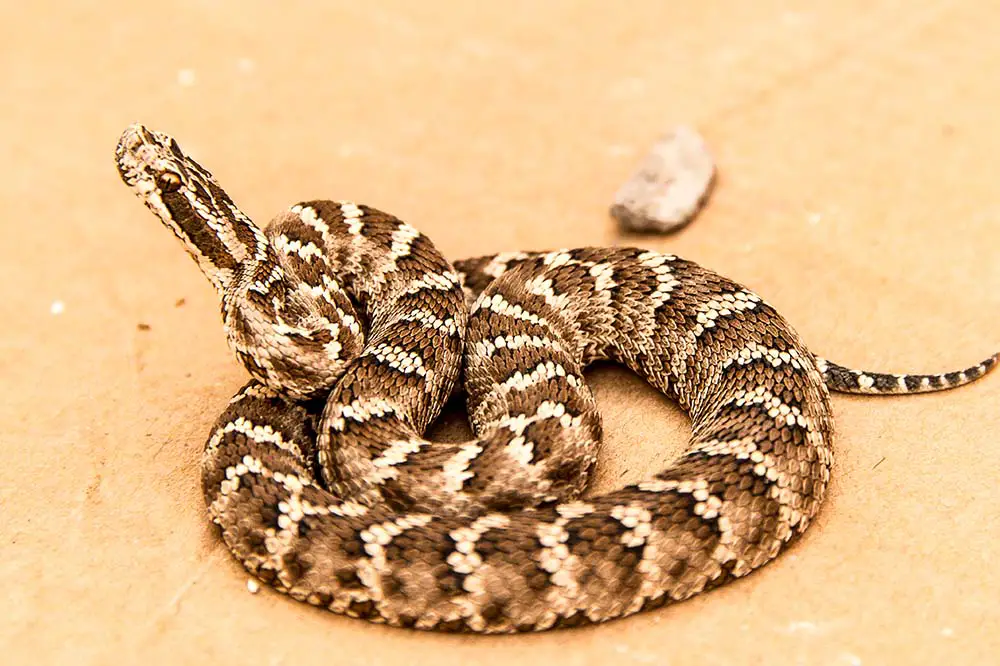
Left: Bactrian camels in Mongolia | Pierre Jean Durieu / Shutterstock & Right: Siberian pit viper Eastern Gobi, Mongolia | Ridinghood / Shutterstock
Temperate grassland in the Palearctic is referred to as steppe and is generally found in the transitional zones between desert and forest, where environmental factors such as precipitation are enough to support the growth of grasses but not sufficient for large amounts of trees. The Volga river passes through the Pontic Steppe and is home to the colourful Russian sturgeon. On land, animals include the critically endangered Saiga antelope, various species of fox, and the majestic steppe eagle.
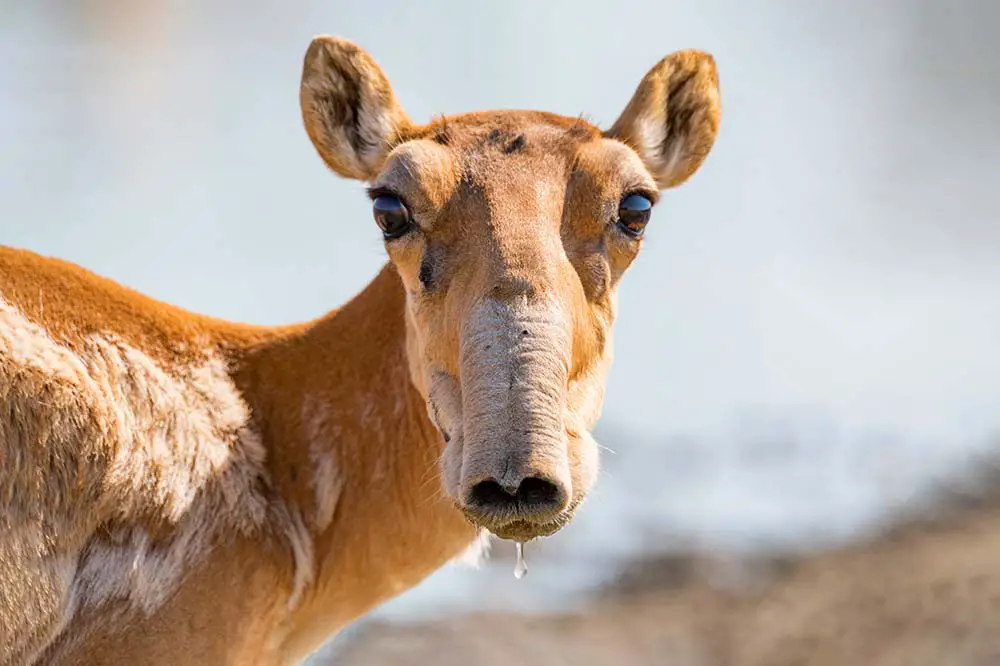
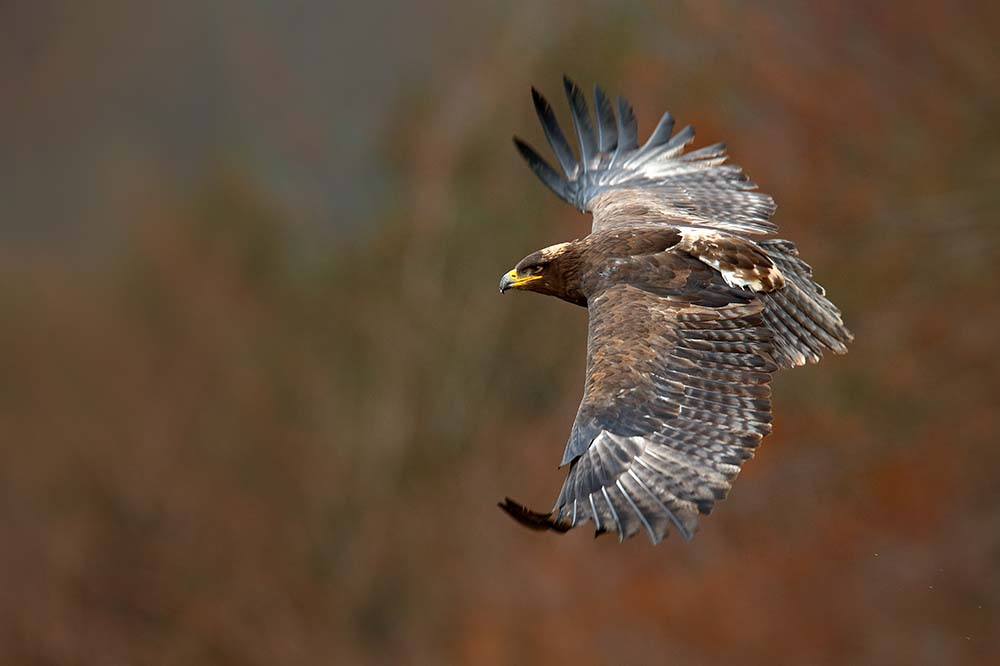
Left: Saiga antelope in the steppe | Yakov Oskanov / Shutterstock & Right: Steppe Eagle | Ondrej Prosicky / Shutterstock
The largest expanse of temperate forest is found to the west and makes up almost all of Europe. Deer are common here and mill about peacefully beside pigeons, whose appearance varies considerably between realms, the western European hedgehog, and the European badger, the United Kingdom’s largest land predator.
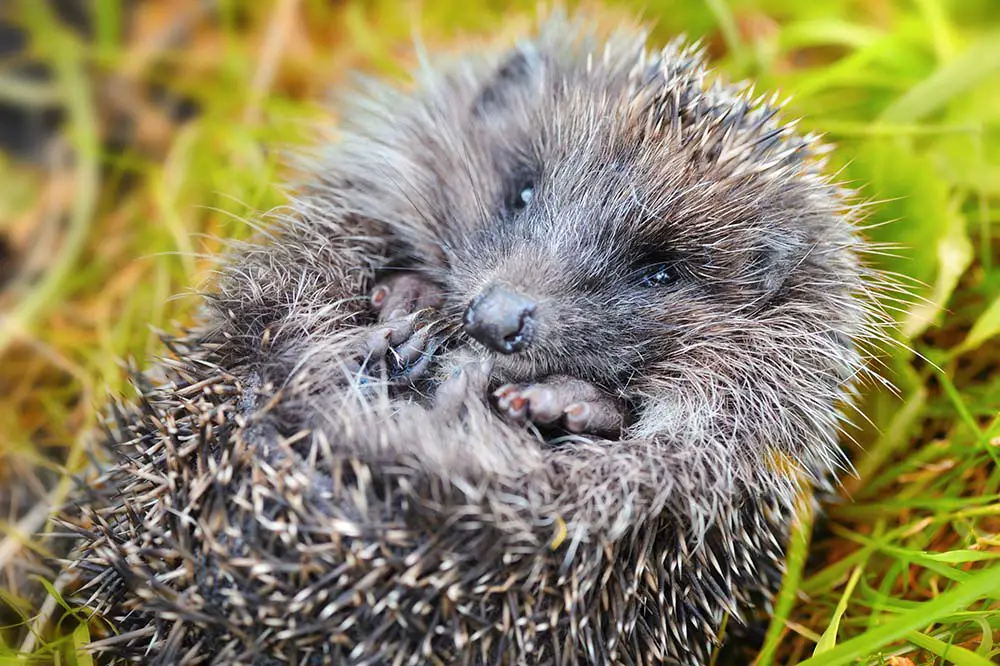
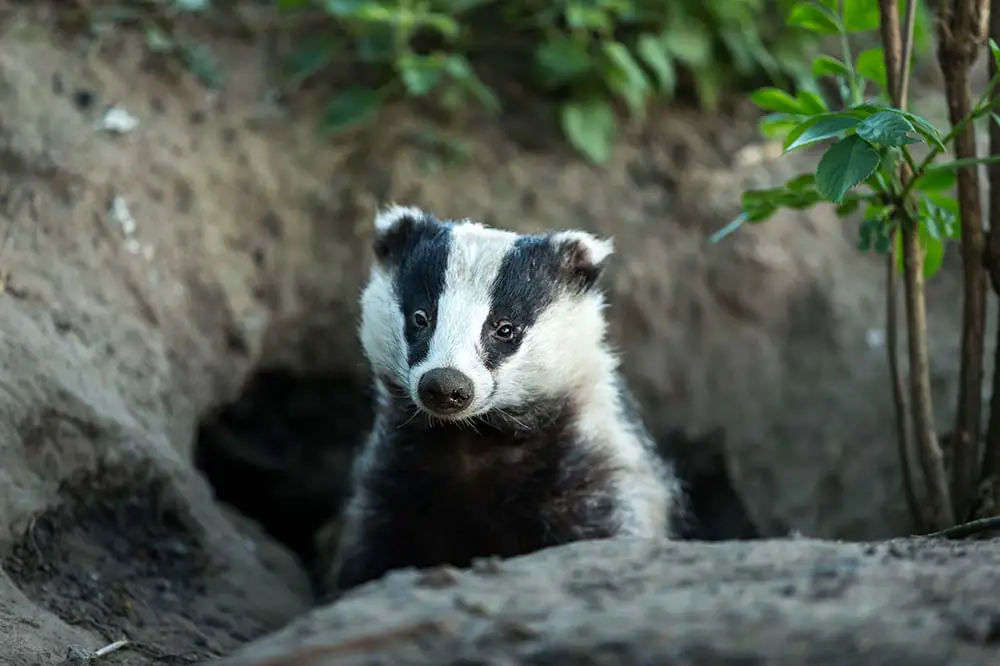
Left: European badger | Coatesy / Shutterstock & Right: Western European Hedgehog | Nataliia Melnychuk / Shutterstock
06 Indomalayan realm
The Indomalayan realm sits to the south of the Palearctic on the other side of the Himalayas. Its mainland body stretches from the Thar desert in the west, which sits on the border of India and Pakistan to southern China in the east. Beneath are its island components, made up of the Philippines and half of the Indonesian and Malay archipelagos. With the exception of the Himalayas, its topography is relatively flat, especially in comparison to other zones although the islands of Indonesia are a well known volcanic hotspot.
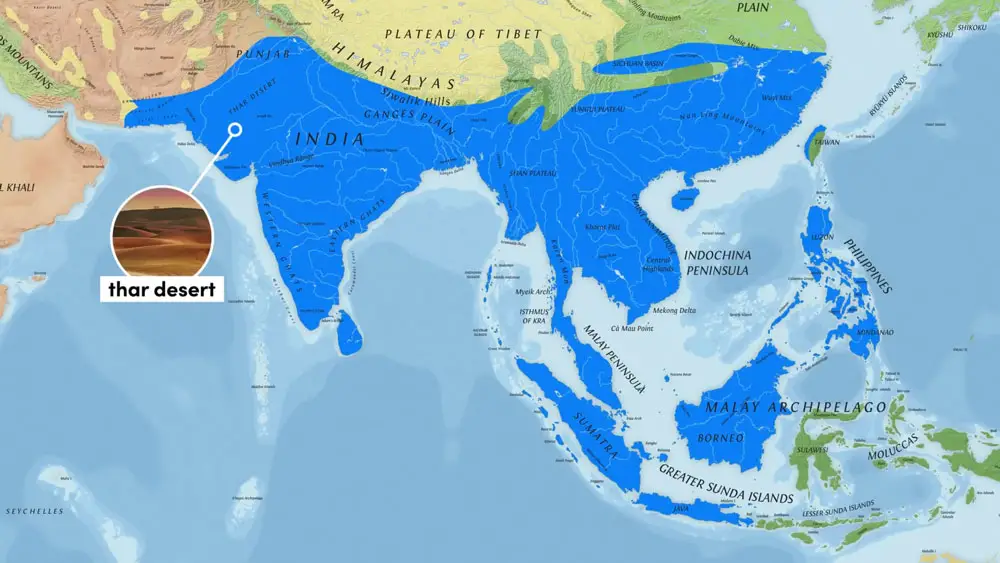
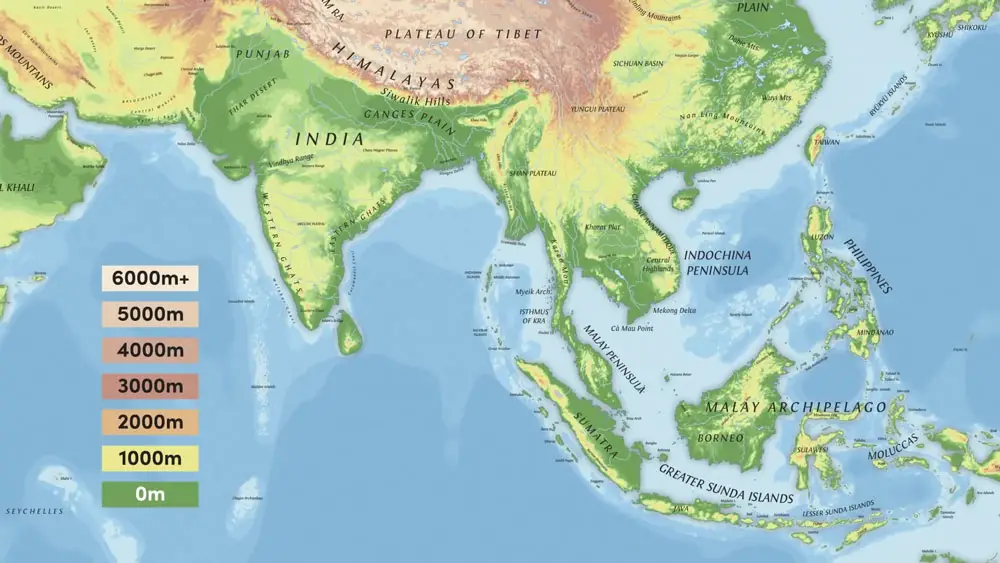
Left: Indomalayan Realm & Right: Indomalayan Topography
This realm is made up almost entirely of tropical forest, which unsurprisingly is home to an astounding amount of biodiversity including the Asiatic version of Africa’s big 5. Various species of water buffalo can be found in the tropical and subtropical forests of this region alongside Asiatic elephants, which although smaller than their African counterparts, can still reach up to 13,000 lbs (13,215 lbs / 6,000 kg). The large felines of this realm include the Asiatic lion, an endangered but heavily protected subspecies of lion found only in India’s Gir Forest, and the leopard, which between its 8 subspecies, has an unusually large range from the southern tip of Africa to far eastern Asia. Completing the big 5 are three species of rhinoceros, including the Indian rhino, also known as the greater one-horned rhinoceros, whose numbers have risen from a bleak 600 in 1975 to over 3,500 by mid-2015 thanks to valiant conservation efforts.
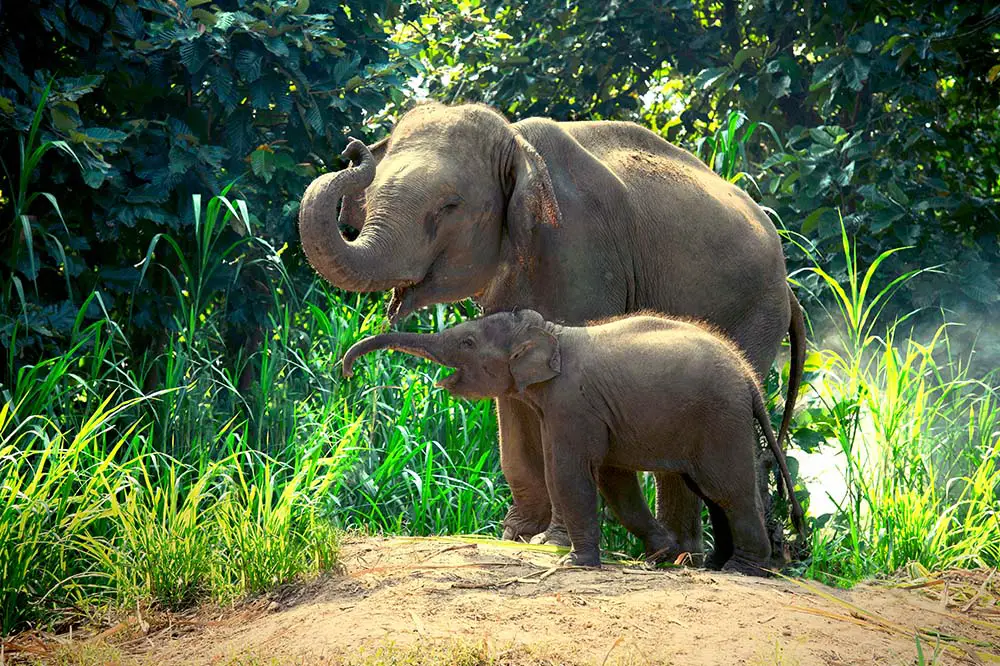
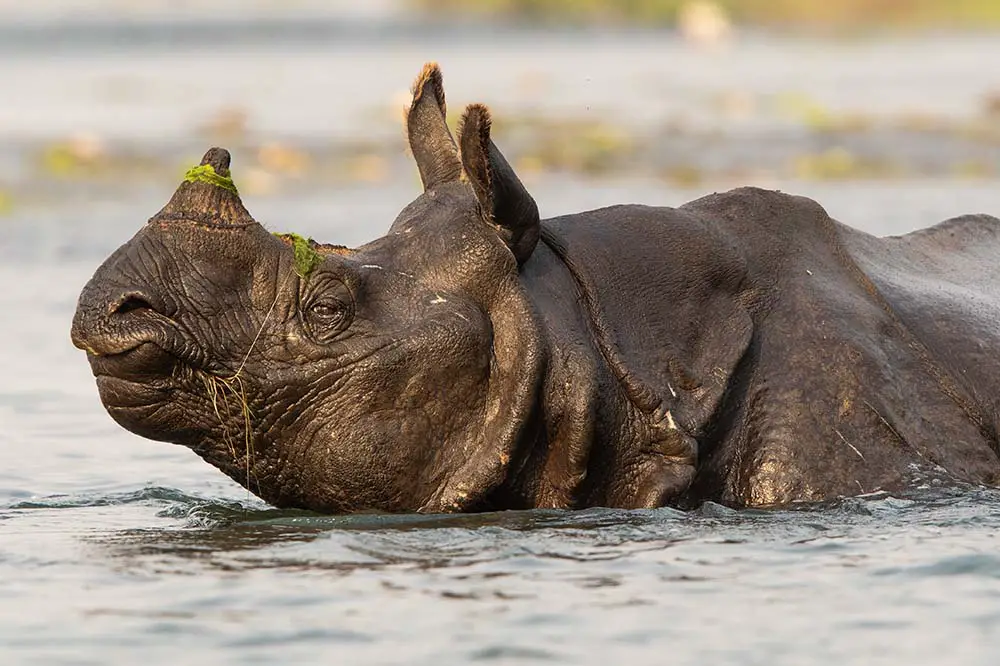
Left: Mother elephant with baby | Nuttaya Maneekhot / Shutterstock & Right: Indian One-Horned Rhino in Nepal | Dominyk Lever / Shutterstock
Another area renowned for its wildlife is the island of Borneo. Orangutans here will live for up to 50 years, they are mostly arboreal and are also found on the island of Sumatra. The Wallace’s flying frog is also arboreal and will use its webbed feet to glide from the treetops when threatened. One of the many colourful birds on the island, the Rhinoceros hornbill secretes a tinted oil from their preen gland when grooming, which is thought to give their bill and casque its red tint. The spiny turtle is one of the most unique species of reptile and although they are found throughout Southeast Asia are classified as endangered.
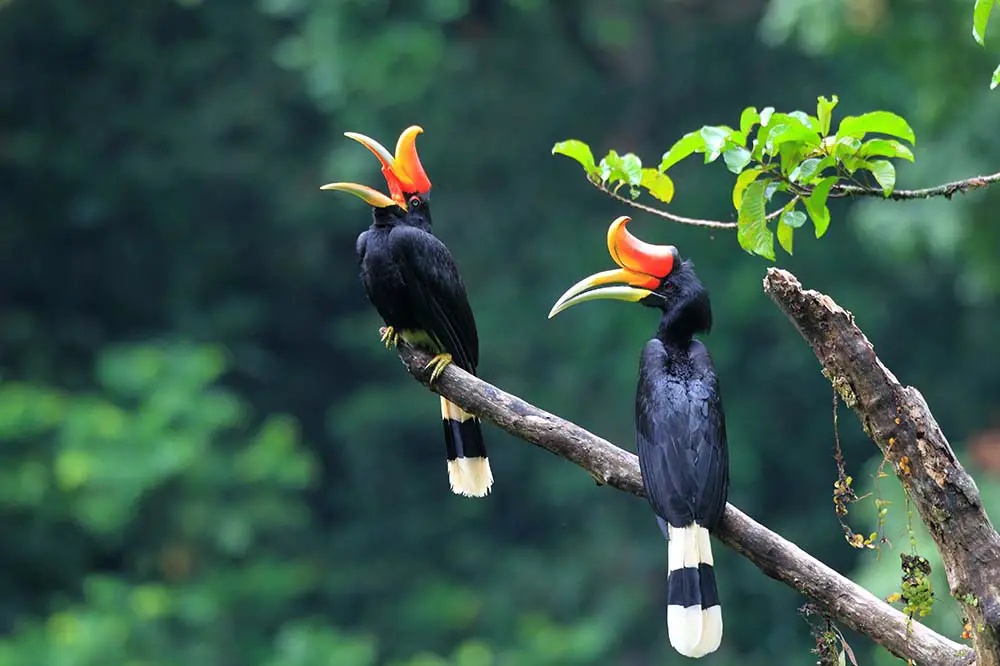
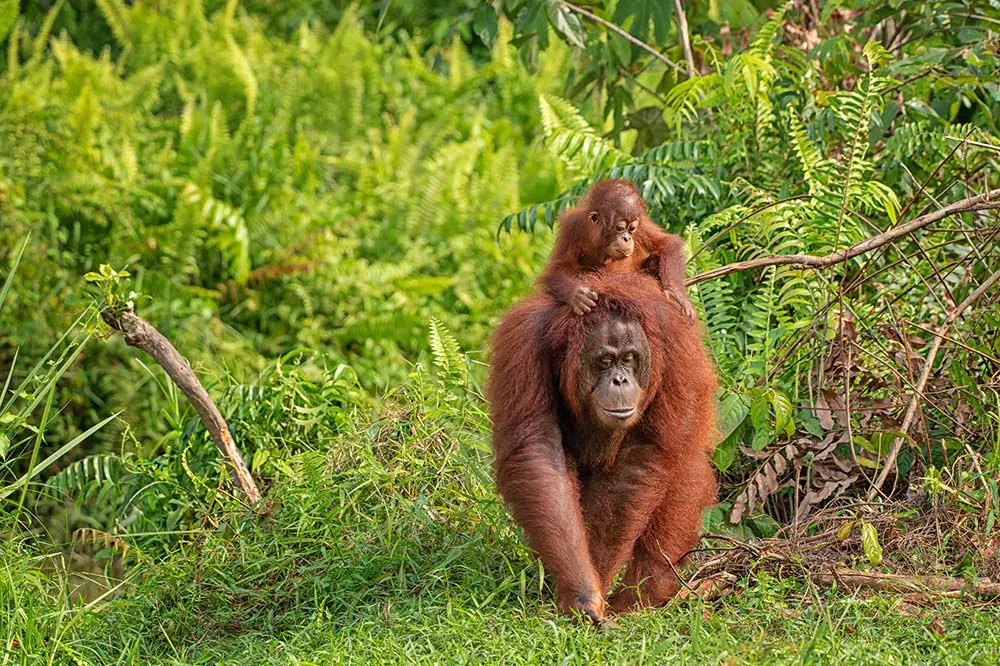
Left: Rhinoceros Hornbill in Sumatra, Indonesia | feathercollector / Shutterstock & Right: Mother orangutan with baby | lukaszemanphoto / Shutterstock
Initially mapped by Alfred Russel Wallace in the 19th century, the southeastern border of this realm has been subject to much debate over the years but lies somewhere between the islands of Borneo and Java and New Guinea and Australia. This faunal boundary is known as the Wallace line and quite frankly, is fascinating. For context, there are three living subgroups of mammals; placentals, marsupials and monotremes. While there are some placental mammals in the Australasian realm, there are no marsupials or monotremes east of the Wallace line. It is thought that this separation is due both to continental drift and changing sea levels with the Wallace line representing a historically difficult boundary to cross for mammals who can’t fly or be transported by humans.
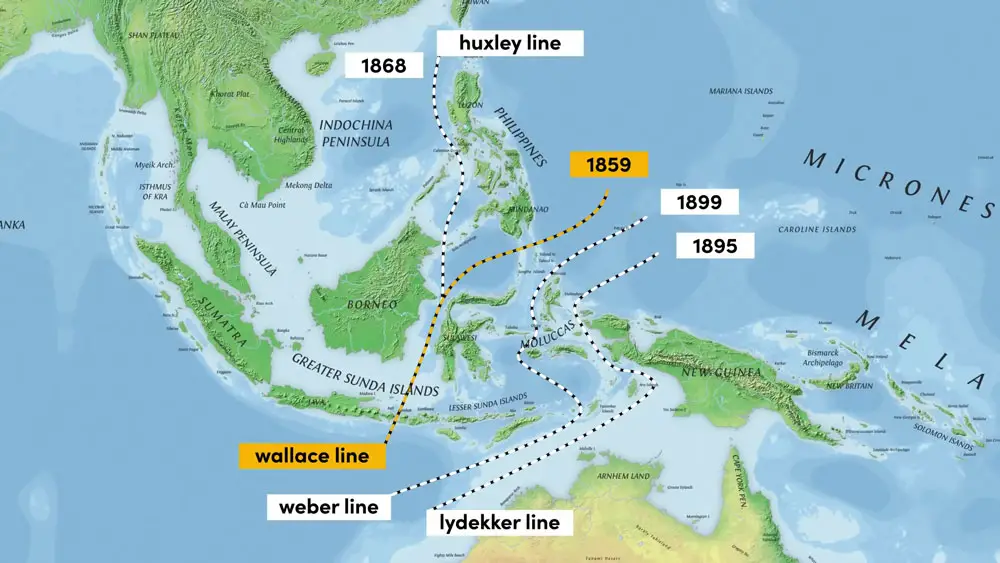
07 Australasian realm
The Australasian realm is positioned on the other side of the Wallace line and comprises New Guinea, Australia, New Zealand and several other smaller island nations. The highest peak in the region is found on New Guinea and is over twice the height of Australia’s Mount Kosciuszko, which stands at just over 2,000m.
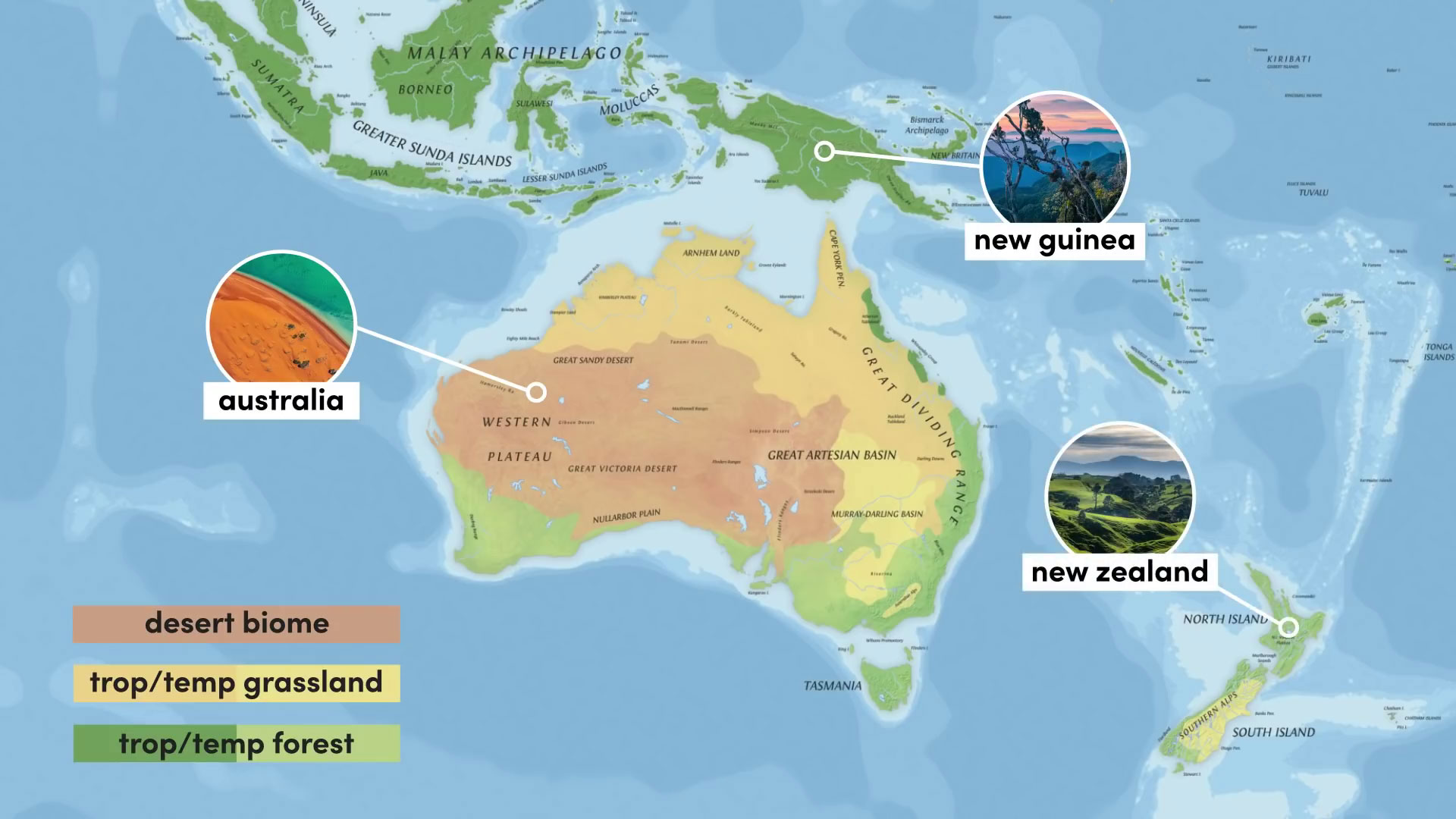
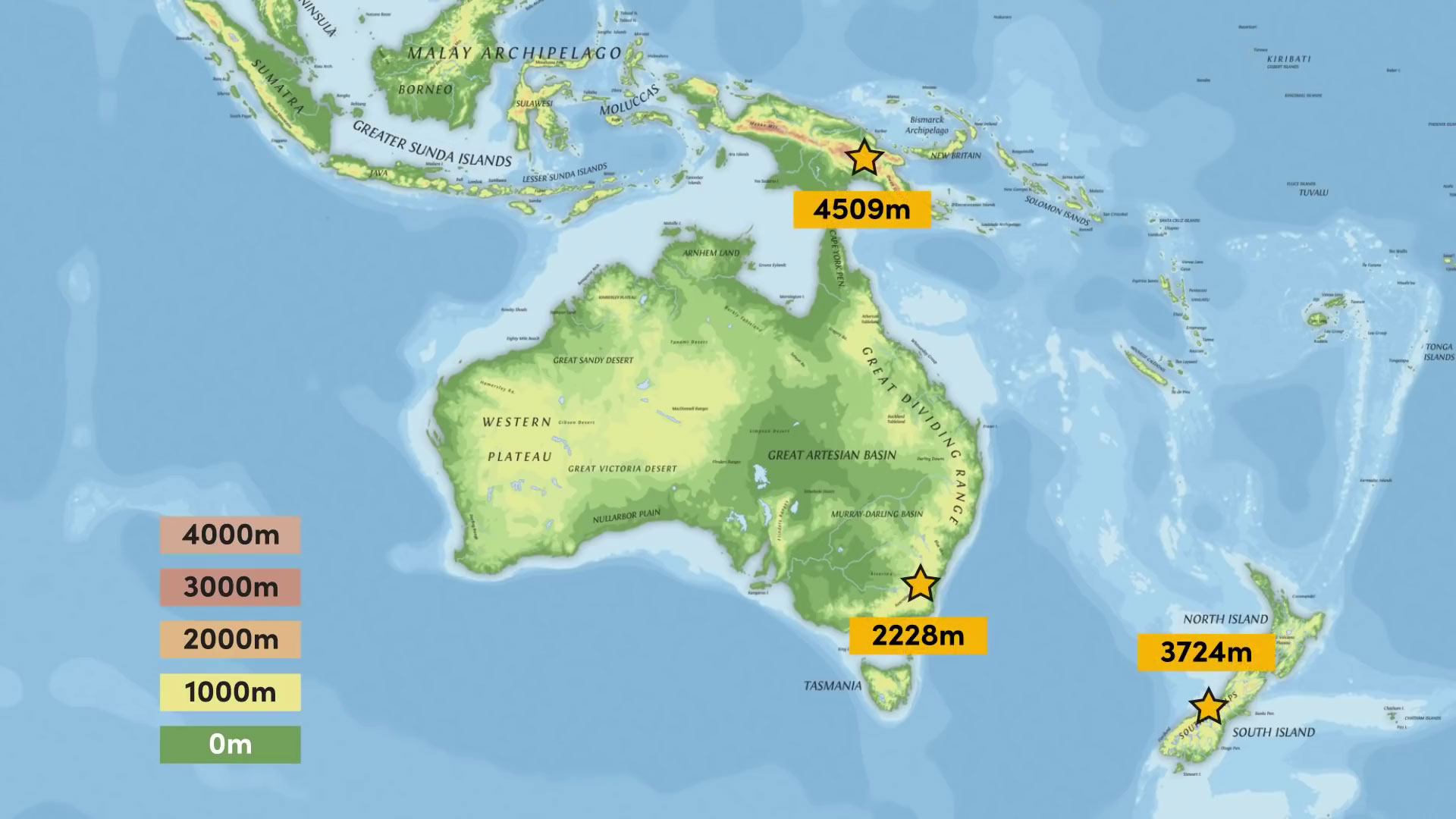
Left: Australasian Biomes and Countries & Right: Australasian Topography
At almost 800,000 square kilometres (785,753 sq km/ 303,381 sq mi) New Guinea is the world’s second-largest island (the largest is Greenland, Australia is usually considered a continental landmass not an island) and features many curious animals including a particularly interesting marsupial, the Goodfellow’s tree-kangaroo. These furry fellows weigh around 7.5 kg (16.5 lbs) and unlike their Australian counterparts have brown and cream fur. The long-beaked echidna is a prime example of a monotreme mammal that exists in this realm and comes very close to but does not cross the Wallace line. The birds of this island are many and include a particularly exotic family known as birds of paradise.
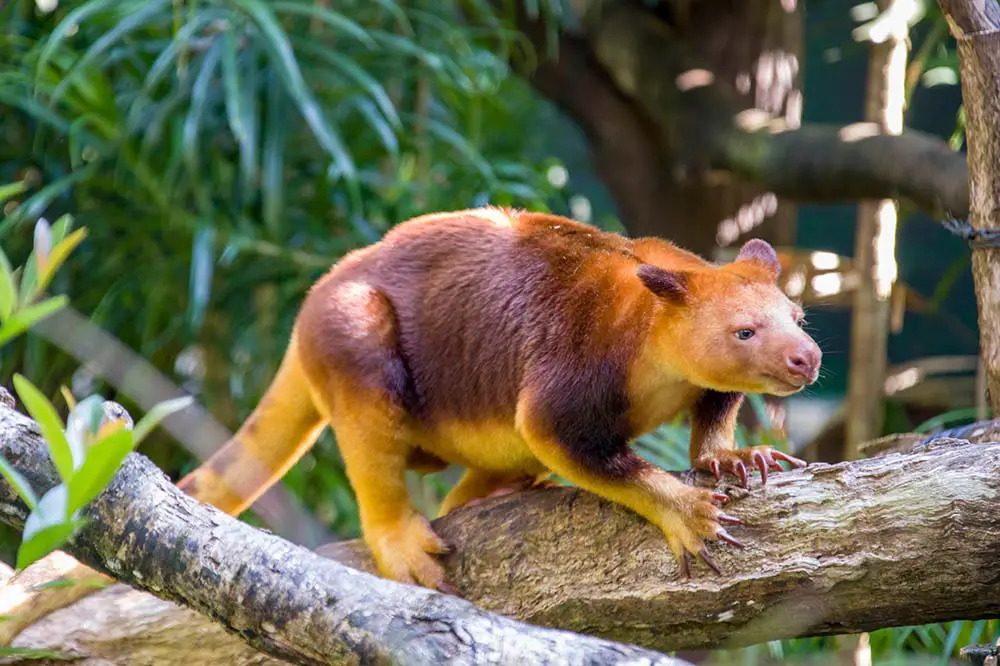
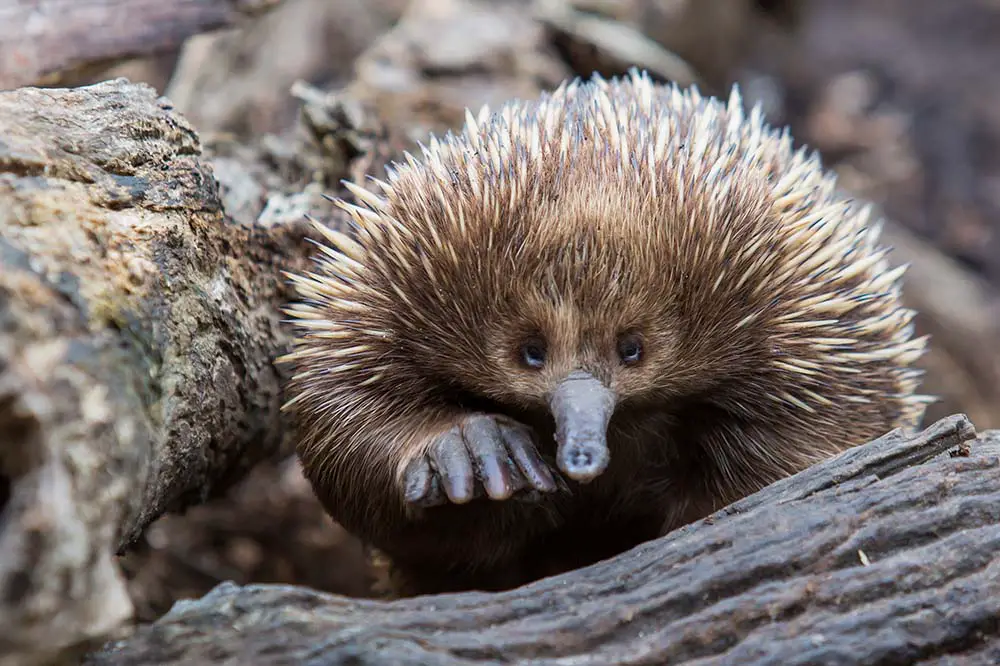
Left: Goodfellow’s Tree Kangaroo | Danny Ye / Shutterstock & Right: Echidna | Kima / Shutterstock
Australia is the world’s 6th largest country and features a wide variety of biomes. The central and western portion of the country is dominated by areas that receive very little precipitation and are therefore classified as desert. The thorny devil is endemic to Australia and in addition to its thorny exterior and intricate camouflage exhibits a fake head on the back of its neck which it uses as a defence when provoked. The red kangaroo is the largest of Australia’s many marsupials and varies in colour between sexes; males are brick-red whereas females are grey. The eastern portion of the country is made up of grassland and forest. Here, koalas can be found traversing the treetops, overseeing wombats, another marsupial who live in underground burrow systems. Australia is of course famous for its snakes and spiders; one of the most striking arachnids is the red-headed mouse spider with males exhibiting a red head and jaws.
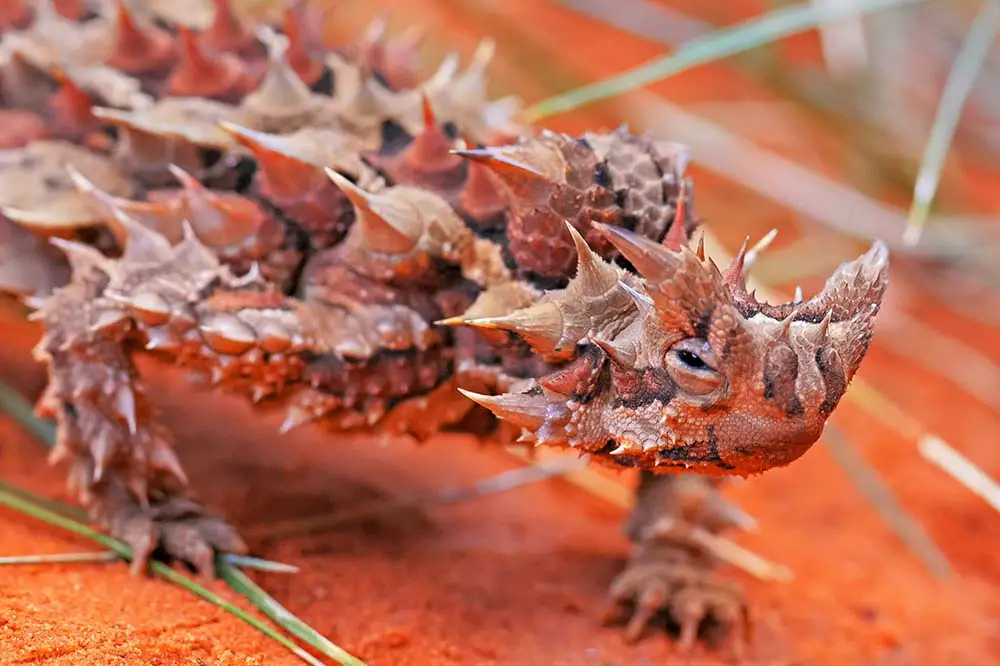
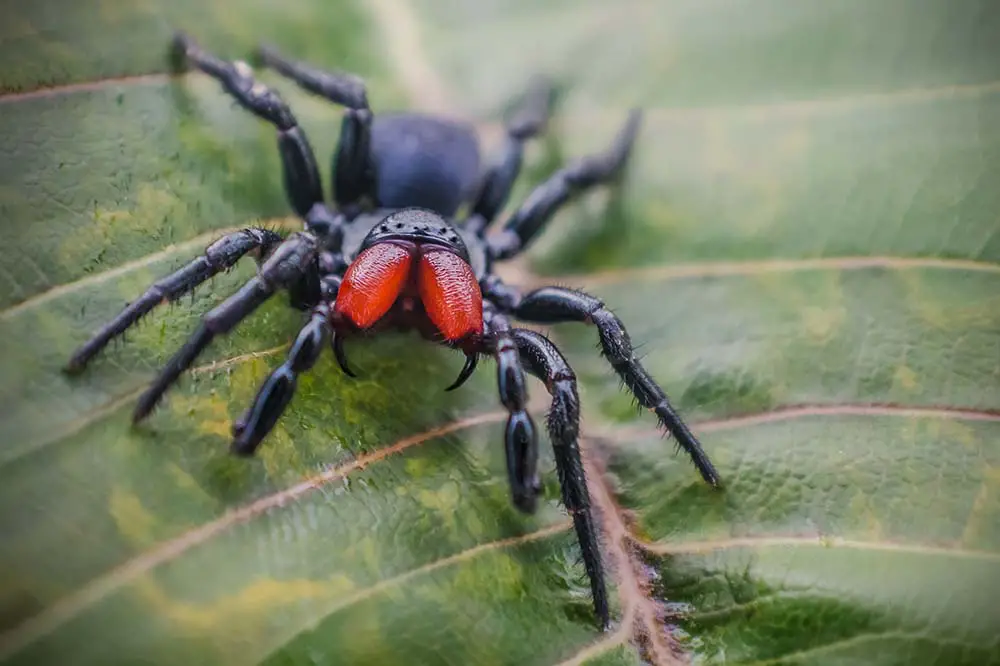
Left: Thorny devil | crbellette / Shutterstock & Right: Mouse Spider | Brittany North / Shutterstock
It would be a travesty to discuss Australia without exploring its waterways and ocean. The saltwater crocodile is the largest reptile on earth, weighing north of 2,600 lbs (2643 lbs / 1200 kg) and exists on Australia’s northern coastline and into Southeast Asia. The species of shark in these waters are numerous and range from hammerheads and tiger sharks to the infamous but beautiful great white.
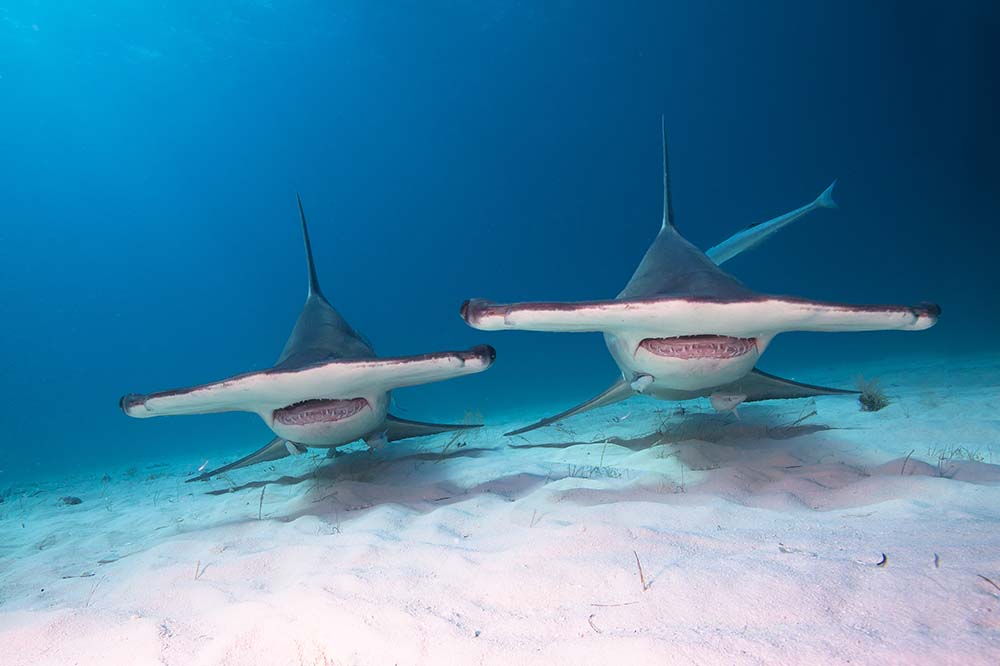
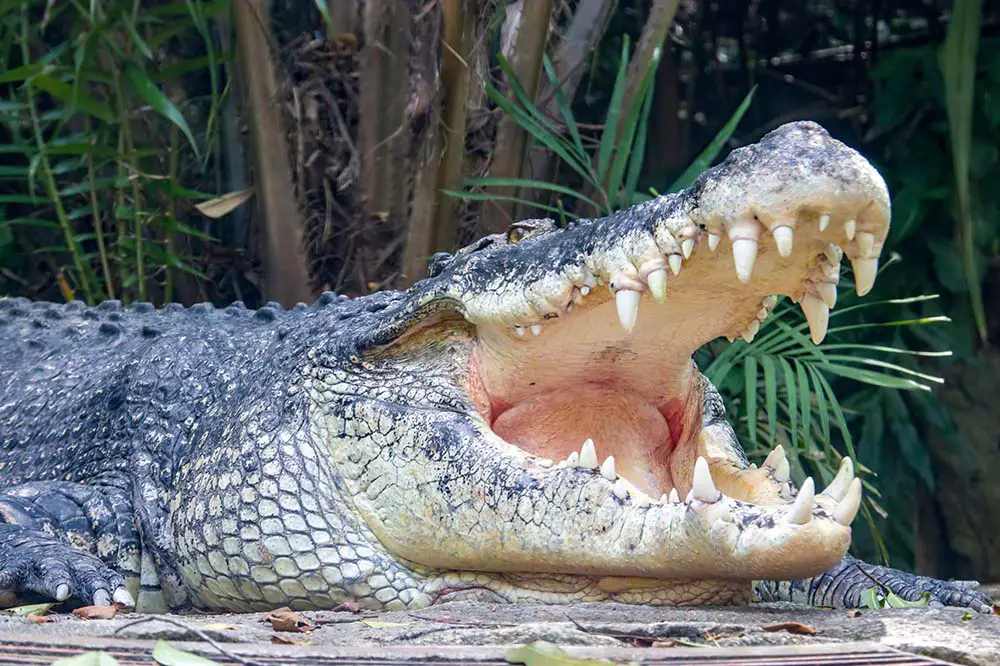
Left: Hammerhead sharks | frantisekhojdysz / Shutterstock & Right: Saltwater crocodile | Danny Ye / Shutterstock
New Zealand is found southeast of Australia and although it is in the same realm, is home to quite a different array of animals. The most iconic by far is the kiwi, after which the humans of these islands are nicknamed. Mammals of the marine persuasion include various types of pinniped such as the New Zealand fur seal and whales such as the Hector’s dolphin, which has a unique colouration. Interestingly, there are no marsupials or monotremes here, in fact, bats or pekapeka in Maori, are the nation’s only native land mammals. Representing the reptiles of New Zealand is the Tuatara, a rare species found on the north island and the very northern tip of the south island.
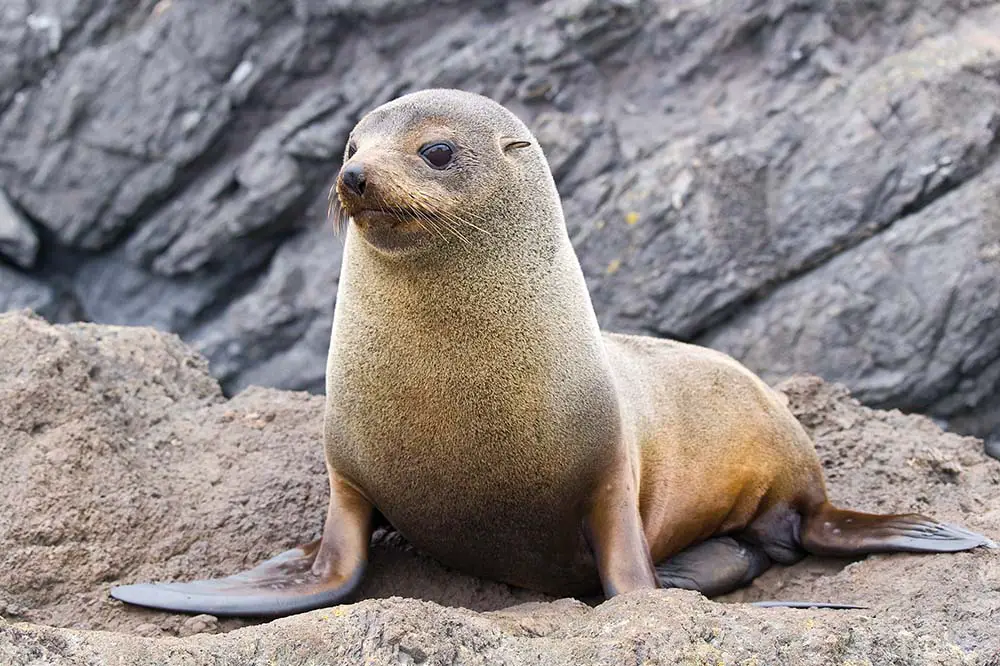
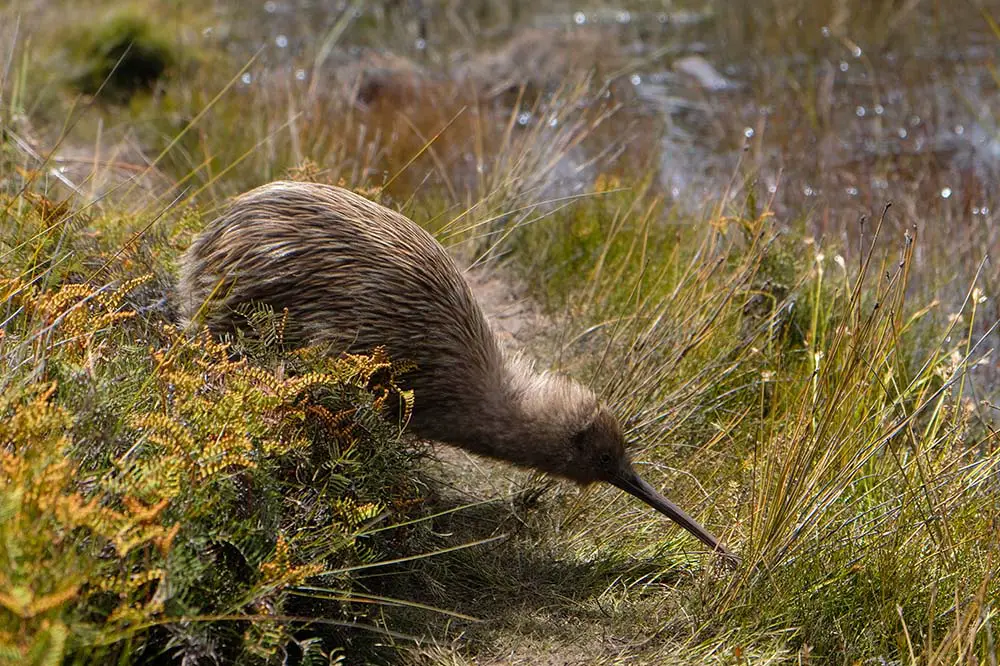
Left: Endangered New Zealand kiwi | Vee Snijders / Shutterstock & Right: Fur seal in New Zealand | Nicram Sabod / Shutterstock
08 Oceanian realm
The Oceanian realm is made up solely of islands in the Pacific Ocean stretching from Japan’s Bonin Islands and Hawaii in the north to Fiji, Tonga and Easter Island in the south. As such, it is the smallest realm on earth by landmass. The topography here is limited due to the size of the landmass but the highest peak in Hawaii still reaches over 4,000m. Migration to and from these islands is limited for land mammals due to the long treacherous stretches of deep water, which is much less of a problem for flying mammals such as bats and species of bird.
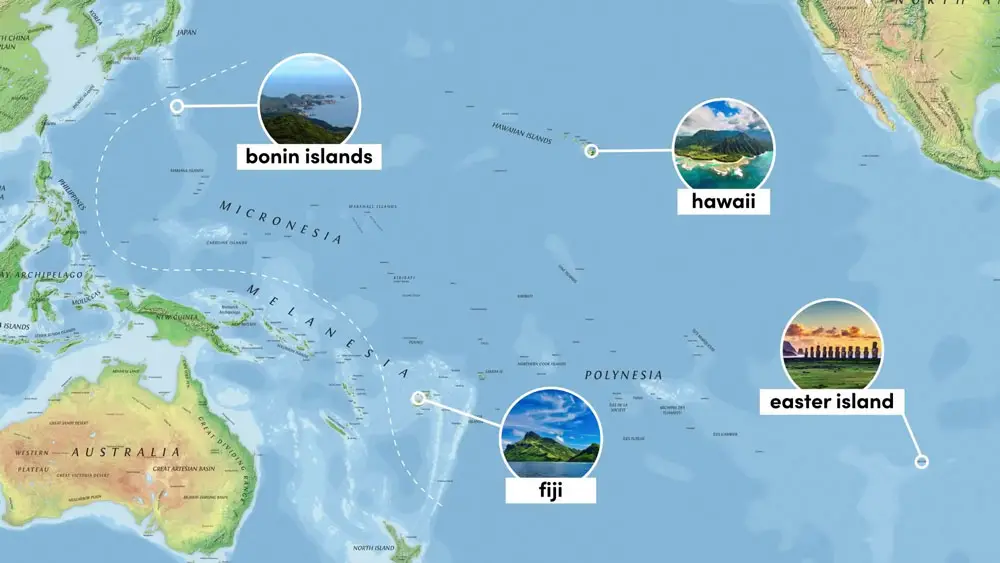
The island of Palau is home to several species of bat from the Pteropus genus, more commonly referred to as flying foxes. Some of the most beautiful bird species include the Nicobar pigeon and the Red-footed booby, which is found throughout the tropics. The clear shallow waters of the Palau archipelago features yellow seahorses who drift along the ocean current with multicoloured mandarinfish.
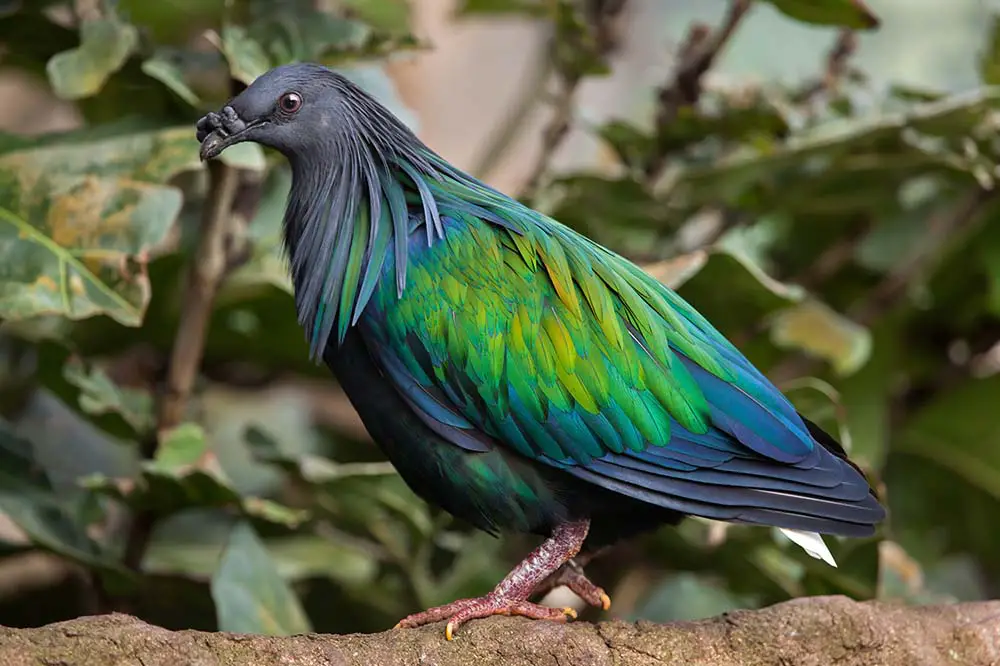
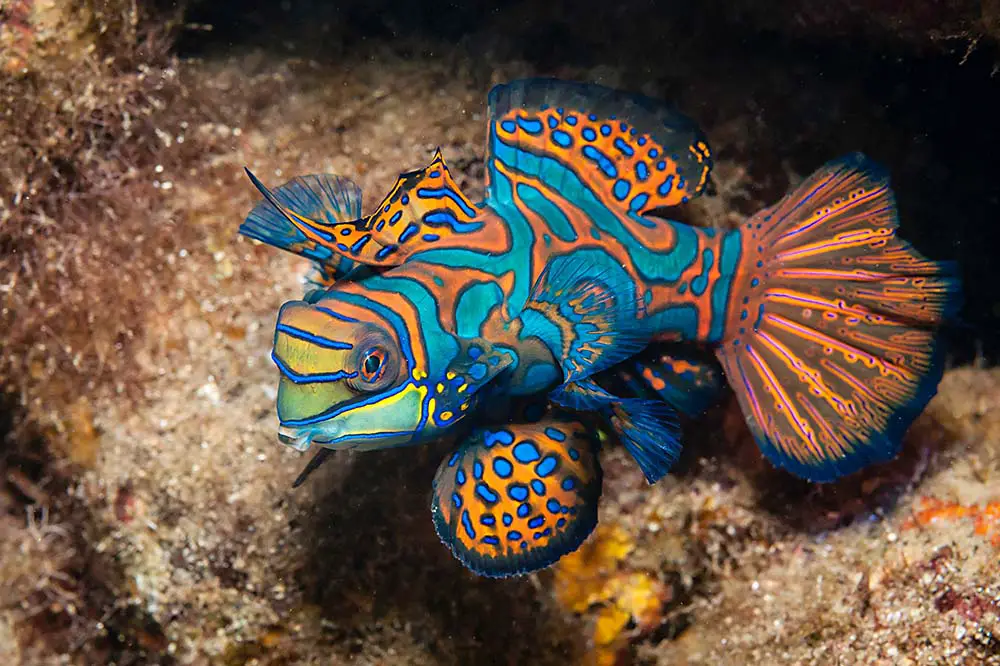
Left: Nicobar pigeon | Vladimir Wrangel / Shutterstock & Right: Mandarin fish | wildestanimal / Shutterstock
Fiji is one of the larger archipelagos in this realm and its array of tropical birds is equally as spectacular; collared lory are common here and at 20 cm (7.9 in) long is roughly twice the size of a Fiji parrotfinch. Reptiles include the Fiji banded iguana, which is endemic and classified as endangered. They are similar in appearance to the Fiji crested iguana, which unfortunately is critically endangered. There are 6 species of clownfish in Fijian waters who compete with the Peacock mantis shrimp for the most colour animals of the reef!
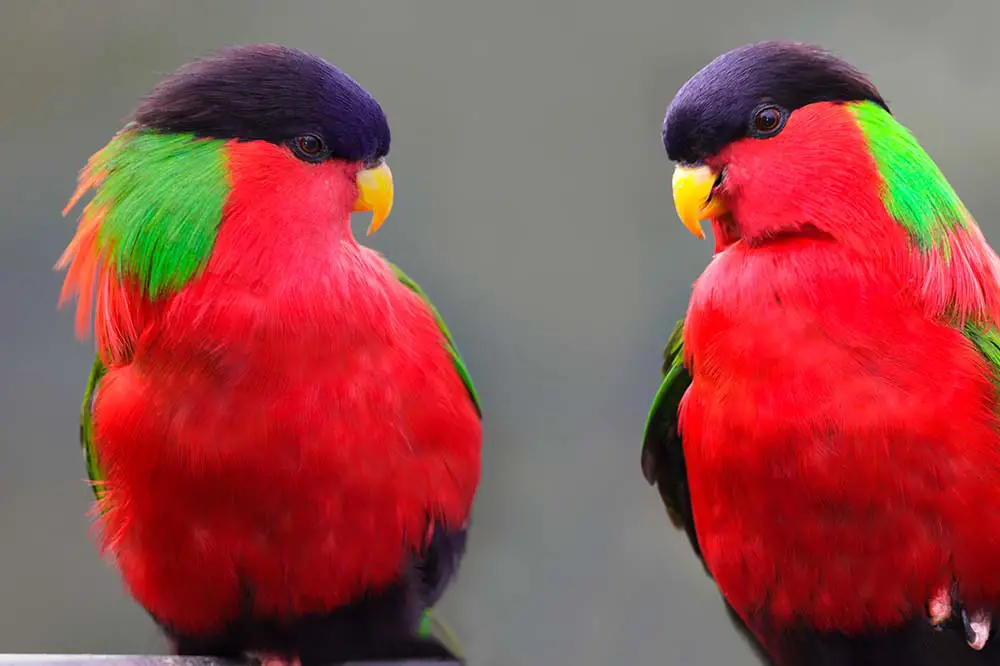
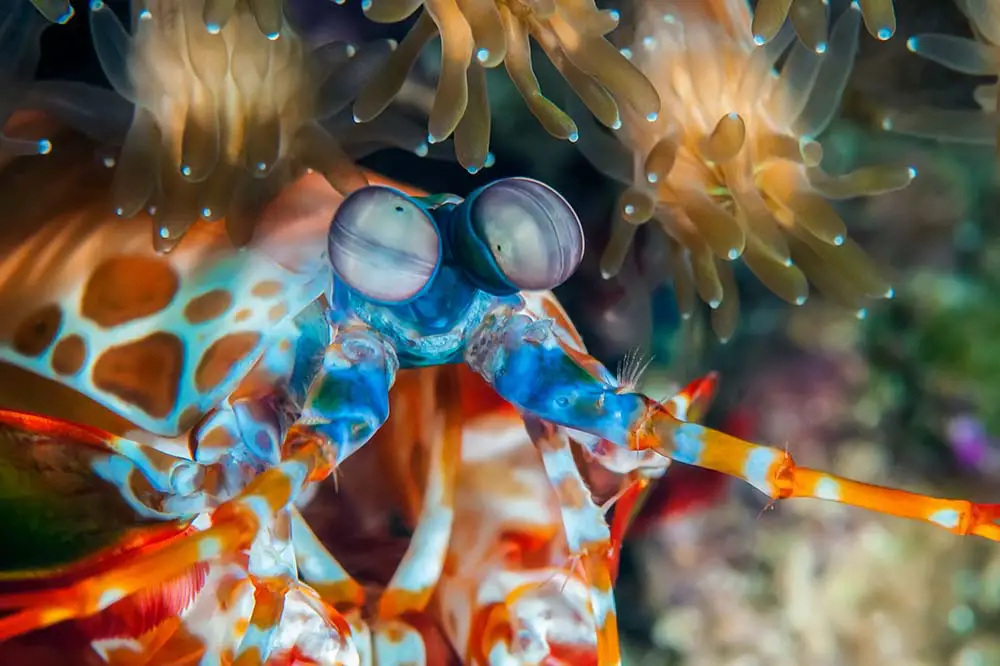
Left: Collared Lory | arak7 / Shutterstock & Right: Peacock Mantis Shrimp | Aleksei Alekhin / Shutterstock
The Hawaiian island of Maui lies over 3,500 km (3678 km / 2,286 mi) from the closest point on the California coastline. It is part of a chain of islands and underwater volcanoes known as seamounts that stretches from Hawaii in the east to Kure Atoll in the west. Hawaii is the youngest, least eroded and most prominent. From Hawaii, the age of the islands increases the further northwest they lie and therefore their prominence decreases due to the time they have had to erode. In addition to the incredible array of birds and marine life that you’d expect from this Pacific chain (Hawaiian honeycreeper), there are many species of animal here that have been introduced by humans. The Indian Mongoose was introduced in the 19th century to combat rat populations in sugar plantations, along with the chital, another Indian species found in Hawaii that was also introduced in the 1800s.
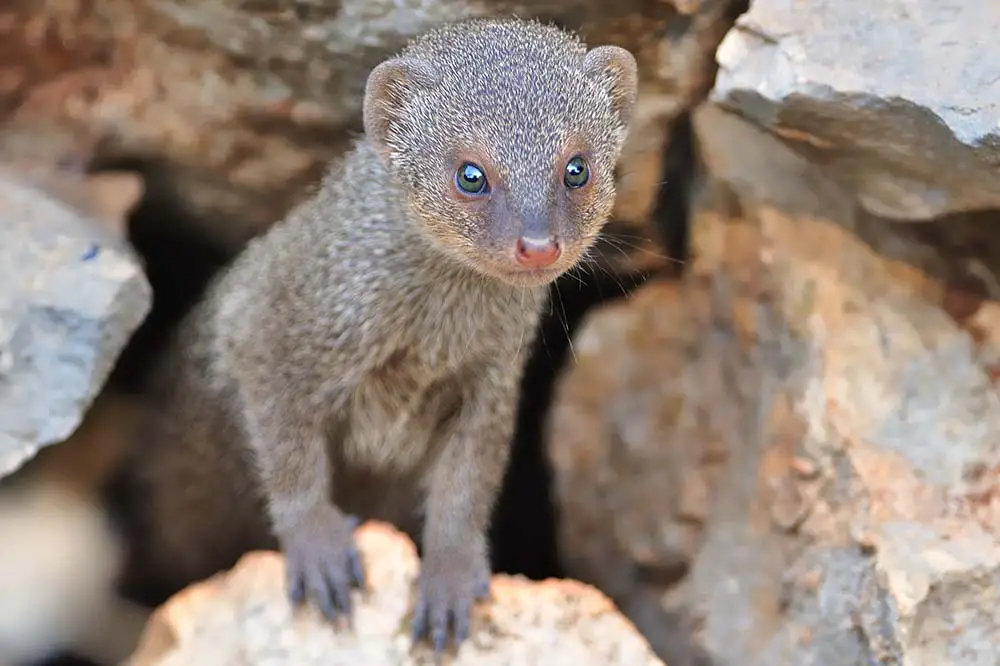
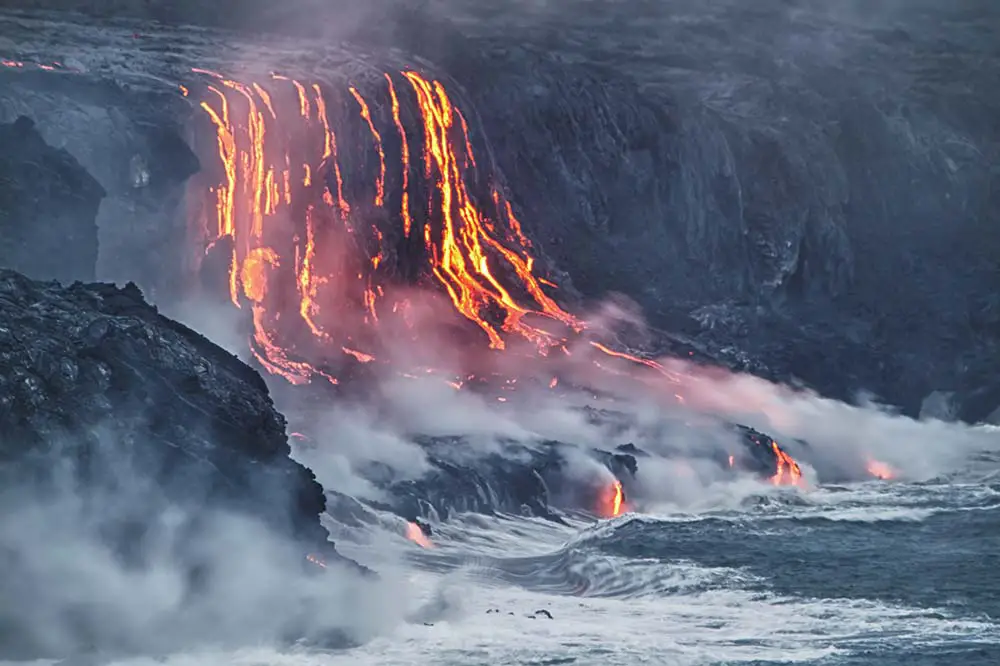
Left: Indian Mongoose Martin Pelanek / Shutterstock & Right: Lava erupting into Pacific Ocean in Hawaii | Alexey Kamenskiy / Shutterstock
